A teacher’s push for smart-tech classrooms
3% reduction in

A teacher’s push for smart-tech classrooms
3% reduction in
rate
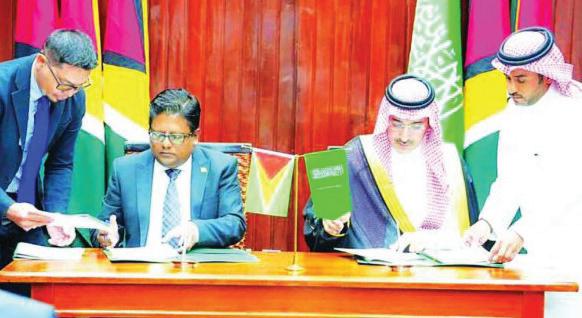
…4 commercial banks on board
…industry stakeholders laud Gov’t efforts to support sector
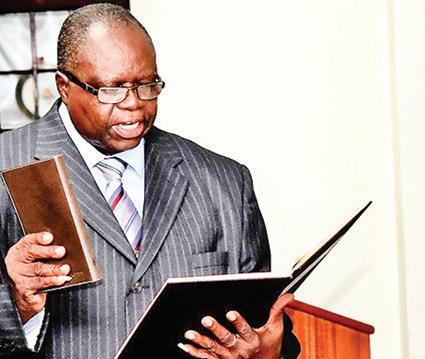
120 complaints processed by Ombudsman between 2021-2022
…complaints include sexual harassment in Police Force
Radiation Safety Bill
$20M fine, prison time for defaulting companies under new legislation
Historic US$150M Saudi loans were secured with 20-year maturity period
Mental Health
“Our job is not to keep people institutionalised” – Health Minister tells Police
Plane’s tyre explodes during take-off at Mabaruma airstrip
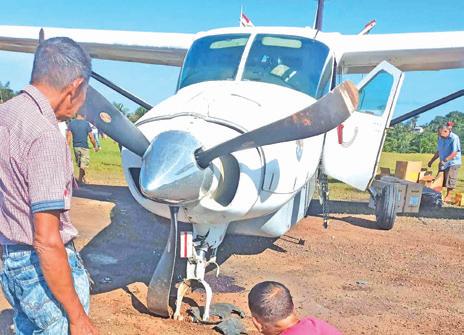
President Dr Irfaan Ali on Saturday said that Guyana’s Afro-Guyanese history is one that every Guyanese should be proud of. He made these remarks while addressing several Afro-Guyanese cultural groups at the Arthur Chung Conference Centre on Saturday afternoon.


President Ali reassured the groups of his Government’s pledge to support Emancipation
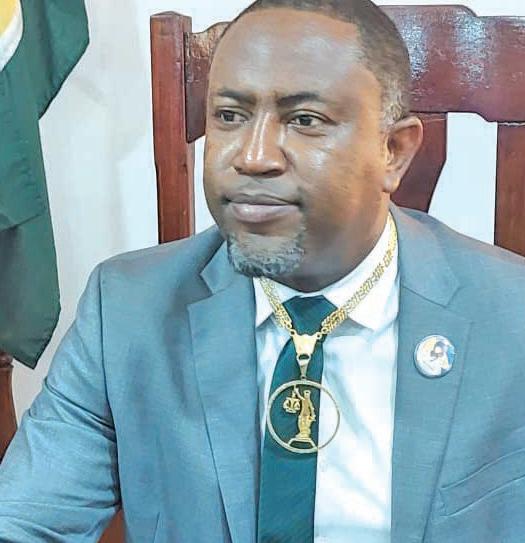
celebrations in August, explaining that the Culture, Youth and Sport Ministry has planned a number of events across the country that will feature educational programmes and cultural activities, among others, on the occasion of the 200th Anniversary of the Demerara Revolt. The President also signalled his intention to revive the “art of drumming” programme.
During the meeting, Ali emphasised that his
approach to managing the country is working directly with people and communities, and his overarching aim is to bring prosperity to every citizen.
“I love working with the masses. Everything we do will be done directly with the people. You will see the President, the Ministers, and all stakeholders coming out to directly work with you, your organisation, and your group,” Ali said.

Over 100-year-old NA Mayor’s ceremonial gold chain missing


…last seen in 2018, new Mayor given modified version
Govt, Private Sector urged to increase collaboration to address labour gap
Older population urged to get medical checkup every year
Court finds Vreeden-Hoop business trespassing into neighbour’s property …orders demolition, awards $1.75M in damages, costs
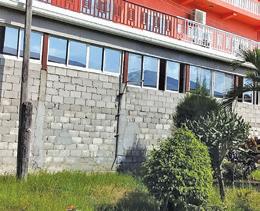
Guyana faces alarming surge in traffic accidents – Police stats
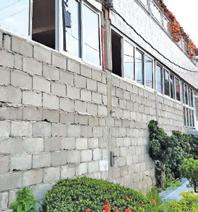
“Everything we do will be done directly with the people” – Ali to Afro-Guyanese cultural groups
Apotentially disastrous incident was averted when the tyre of a single-engine Cessna Grand Caravan exploded just as it was
preparing to take off at the Mabaruma Airstrip in the North West District, Region One (BarimaWaini). The incident which oc -
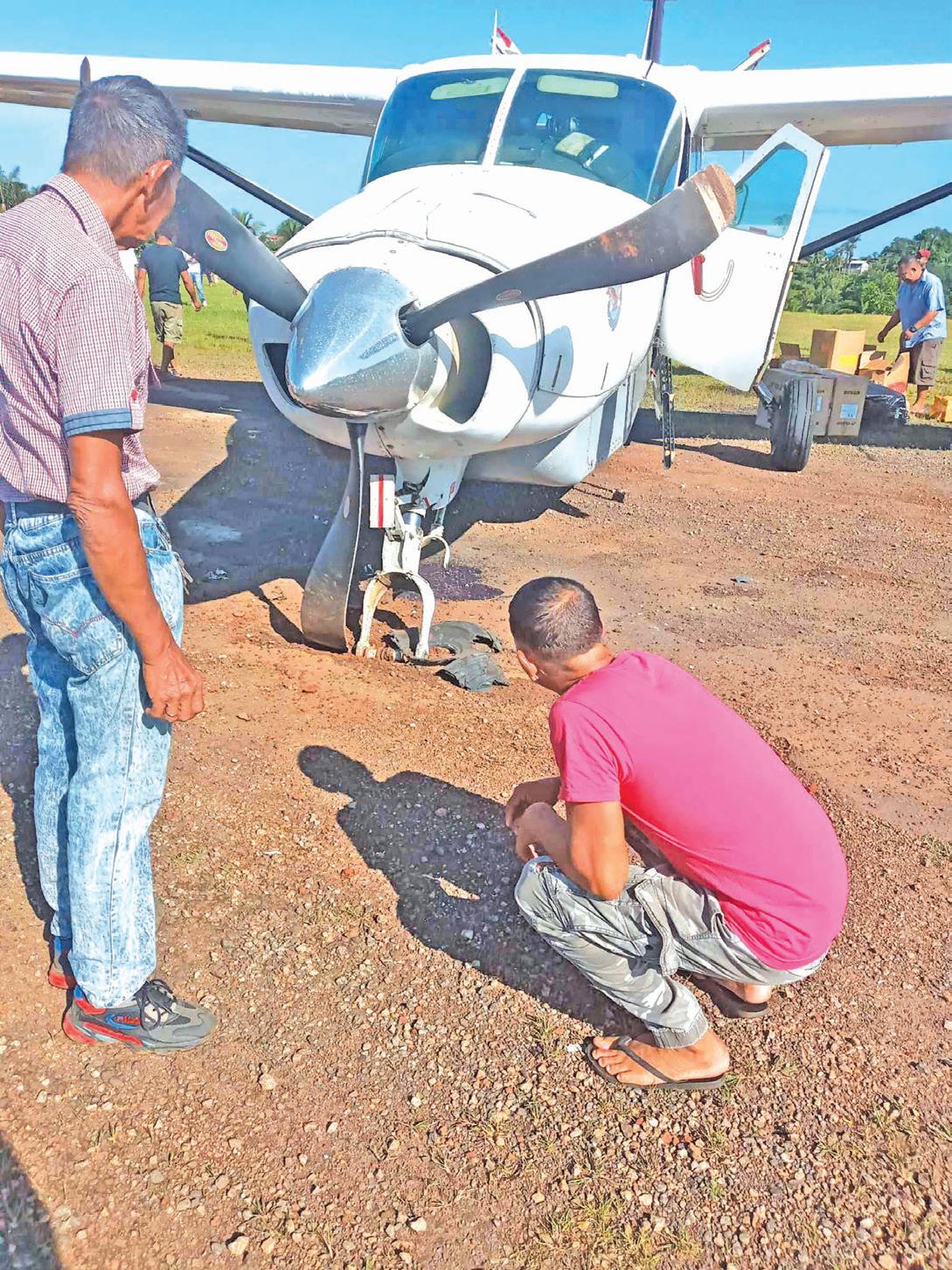
curred at about 10:00h on Friday, sent panic among the passengers on board but fortunately, no injuries were reported.
According to eyewit -
nesses from the community, passengers bound for Georgetown had boarded the aircraft, and shortly after it turned onto the runway, the tyre suffered
a blowout.

As a result of the blownout tyre, the plane's propeller struck the ground, leading to the engine's shutdown. It was reported that the situation could have been far worse if not for the quick response of the pilot and the prompt action taken by airport personnel.


Videos the scene captured the damaged Cessna Grand Caravan, emphasising the severity of the tyre malfunction and the potential disaster averted by the crew's skilful handling of the situation.
Officials at the Mabaruma Airstrip, in
collaboration with aviation authorities, are currently investigating the cause of the tyre blowout to prevent similar occurrences in the future.
Last year September, a similar incident occurred when a plane crash-landed at the Eteringbang Airstrip in the Cuyuni District, Region Seven. The incident took place during stormy weather, and the sky was described as dark and black by an eyewitness. Luckily, all eight adult passengers and the pilot escaped unhurt, but the aircraft suffered significant damage.
(G9)

The Demerara Harbour Bridge will be closed to vehicular traffic on:

Sunday, July 23 – 06:00h – 07:00h and

Monday, July 24 – 23:59h.
The Berbice Bridge will be closed to vehicular traffic on:
Sunday, July 23 – 07:10h – 08:40h and
Monday, July 24 – 07:50h – 09:20h.


Parika and Supenaam departure times –05:00h, 10:00h-12:00h, 16:00h, 18:30h daily


There will be thundery showers and sunshine during the day. Expect clear skies at night. Temperatures should range between 22 degrees Celsius and 30 degrees Celsius.

Winds: Easterly to East South-Easterly between 1.34 metres and 4.47 metres.
High Tide: 07:52h and 20:15h reaching maximum heights of 2.47 metres and 2.4 metres.


Low Tide: 13:50h reaching a minimum height of 0.78 metre.




SUNDAY, JULY 23, 2023 | GUYANATIMESGY.COM
In a move to boost Guyana’s food security efforts, President Dr Irfaan Ali has announced that the People’s Progressive Party/Civic (PPP/C) Government has managed to broker the reduction of interest rates on loans to poultry farmers from 8 per cent to 5 per cent.
President Ali made the announcement on Saturday, while addressing stakeholders in the poultry sector at State House. According to him, at least four commercial banks in Guyana have agreed to reduce their interest rates on loans to poultry farmers/operators.
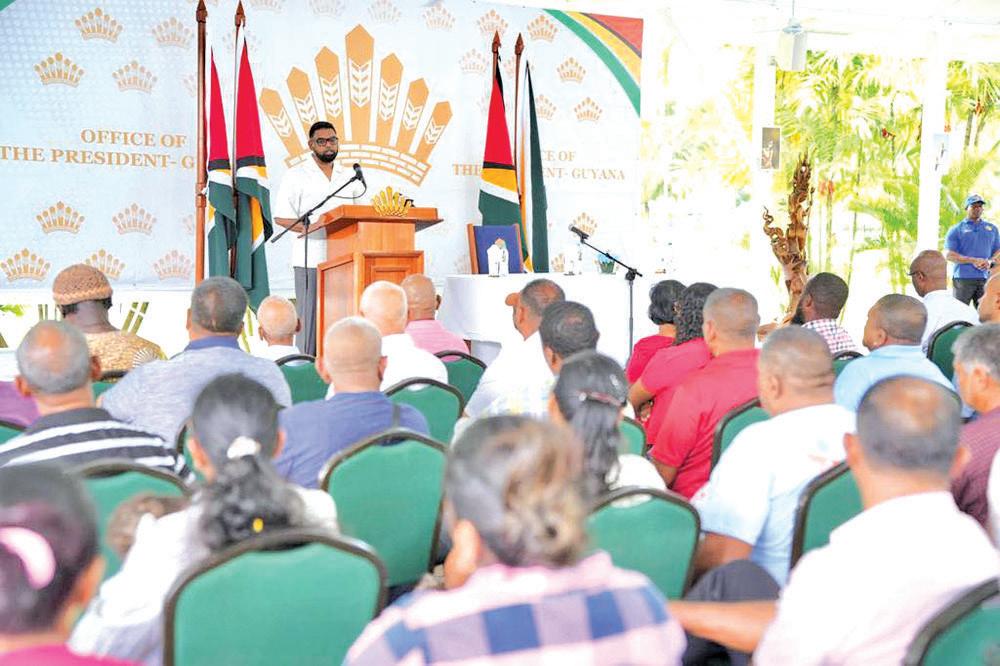
This means that small, medium, and large-scale farmers are expected to benefit from this 3 per cent lowering of the interest rate. He went on to add that poultry farmers and operators with existing loans at these four banks will also benefit from this new lowered interest rate from next month.
“We will introduce a facility under which the interest income earned by commercial banks on loans granted to the poultry sector will be free of corporate income tax. This now will enable commercial banks to lower their interest rate, the charge to the poultry sector by almost 3 per cent; from 8 per cent to about 5 per cent.”
“I’ve concluded discussions with a number of commercial banks… Citizens Bank, Republic Bank, Demerara Bank, and GBTI would have all agreed that the interest rate as a result of this measure by the Government will be reduced from 8 per cent to 5 per cent. That is a 3 per cent reduction in your interest rate,” the President explained.
President Ali noted that these commercial banks have all decided to fully participate and that the reduction in interest rate will be done almost instantaneously. And he urged those involved in the sector to take advantage of the move.
“This latest measure represents the latest step taken by the Government to promote food production, increase food supply, and reduce the costs of basic food items to the final consumer… I’m very pleased that all the commercial banks I mentioned have already taken the decision to fully participate and to move towards the reduction in interest rate almost instantaneously as this measure takes effect, now bringing down the effective interest rate for the poultry sector.”
“And this is the poultry sector across the board. All investors in poultry and poultry sector would benefit from this. I therefore now encourage all the farmers and stakeholders in this sector to take advantage of the benefits that will arise from the reduced cost of financing that will now be available to the sector,” Ali stated.
From an oversight side, President Ali meanwhile warned that there would be increased patrols by the Guyana Livestock Development Authority (GLDA), aimed at reducing smuggling. A draft sectoral development plan is
also in the works and is currently being reviewed by stakeholders.

When it comes to other agencies, President Ali said his Government is taking a number of measures to address the poultry sector. This includes strengthening the National Poultry Association and the Guyana Livestock Development Authority (GLDA), engaging with the Mahaica Mahaicony Abary - Agricultural Development Authority (MMA-ADA) and the Guyana Lands and Surveys Commission (GL&SC) on allocating land for the poultry sector. This includes identifying another 25,000 acres of land for the production of rice as an input to feed.
“As you know, the cost of feed goes up because of the cost of input… 70 per cent of the chicken, that is the final product, rice as a component of feed from 2020 would have increased by 100 per cent. Soya bean and corn by 62 and 57 per cent, respectively. We’re trying to have more control pf the input cost by opening up opportunities for the industry.”
“We’ve equipped the GLDA nutrition lab with additional instruments. We’ve equipped
the quarantine and surveillance unit with tools and equipment worth $13 million. We’re training technical staff in good poultry practices. And we intend to extend this training to farmers,” President Ali said.
Other measures have included working with the Ministry of Public Works on reducing transport costs and introducing more hatcheries. This includes a new hatchery in Region Five that can accommodate 20,000 chicks per week. They are also looking to acquire a cold storage facility to support farmers.
Govt lauded
Meanwhile, the announcement of reduced interest rates has since been welcomed by the Private Sector Commission (PSC), which in a statement extended congratulations to the Government of Guyana for deciding to grant reduced interest rates on agricultural loans for poultry farmers - a decision they noted stemmed from President Ali’s recent meeting with the Minister of Agriculture, poultry farmers and the local commercial banks.
“The Commission regards

this decision as a positive step towards enhancing the livelihoods of the poultry farmers. The Commission looks forward to the poultry farmers now utilising this decision by the Government to modernise and upgrade their production facilities and increase their production to ensure that Guyana becomes self-sufficient in poultry production.”
“The PSC takes the opportunity to commend the Government on this and other initiatives to encourage private-sector development in Guyana and will continue to advocate for the growth and development of our country,” the PSC said in their statement.

Also issuing a statement was the Guyana Poultry Producers Association (GPPA), which expressed its support for this and other measures the Government has been implementing, including boosting the GLDA and procuring vaccines for poultry farmers to improve their stock.

“The Association is greatly appreciative of His Excellency’s swift action to address the concerns of the industry and to alleviate the hardships being faced by poultry producers. These actions are a tangible demonstration of the Government’s commitment, under President Ali’s leadership, to address in a meaningful manner the issues that are critical to ensuring adequate production and affordable availability of essential food items for the Guyanese people.”
“The Association reiterates its commitment to work closely with his His Excellency President Dr Mohamed Irfaan Ali and his Government in pursuit of the country’s food security agenda,” the GPPA said. (G3)
News Hotline: 231-8063
Editorial: 231-0544
223-7230,223-7231,231-0544, 225-7761
Marketing: 231-8064 Accounts: 225-6707
Mailing address: Queens Atlantic Industrial Estate Industrial Site, Ruimveldt, Georgetown
Email: news@guyanatimesgy.com, marketing@guyanatimesgy.com
While we have been receiving oil revenues since 2019, all Guyanese would concede – whatever their take on the state of our statistics – that poverty in our country remains quite widespread. Unquestionably, between 1992 and 2015, the PPP Government worked diligently under the ministrations of the IMF -which they inherited from the PNC because of their unsustainably high debt – to reduce that horrendous poverty rate. But while we ascended the World Bank ratings from a Highly Indebted Poor Country (HIPC) to an Upper Middle-Income Country (UMIC), this also raised the classification of our poverty rate. For an UMIC, this is the percentage of the population subsisting at below US$5.50 daily – in our case 48% as of 2019, during the APNU regime.


The PPP Government has committed to using the oil revenues to develop and diversify our economy, to create sustainable growth when the oil runs out in about three decades, at the present estimates of reserves and plan of depletion. There have been several critiques of the Government’s focus at this stage of its development plan, that focuses on infrastructure – roads, bridges, highways etc to “open up the country” and attract businesses that would provide jobs in all regions. While the legislated and implemented local content requirements have created a large number of jobs, most of these demand specific skills that take time to be inculcated. In the meantime, it is obvious that even though the Government has also implemented large-scale training programmes, it will take some time for the poverty rate to be decreased significantly – especially in rural and hinterland regions.
One proposal from an Opposition party is that the Government should disburse annual cash grants of US$5000 per household – with no needs test. This would expend more than US$1 billion annually with no guarantee that the money would be used sustainably. This has not found favour, and the thrust for a sustainable reduction of poverty continues unabatedly. One exciting area is the embarking on a massive drive to create mega-farms in our Intermediate and Interior Savannahs to produce food and grains to fulfil the “25 by 25” Caricom plan to reduce food imports by 25% by 2025. This initiative, however, demands massive capital investments in infrastructure for transportation, drainage and irrigation. Another area that needs massive investment is to produce low-cost electricity to attract manufacturing plants and open up the need for unskilled workers. All of these initiatives demand massive capital expenditures, which can come from our oil revenues. Loans are more easily sourced because of the cash flow from those oil revenues to service them.
But there has appeared another point of view on those revenues, that has astounded most Guyanese but perversely gains traction in one segment of the press that is doggedly opposed to the Government. These Guyanese, who generally reside abroad, have been gripped by the climate hysteria in the west that evidently blinds them to the priorities of any Guyanese Government to its people. They demand that we leave all our oil under the Atlantic, since their hysteria is created by the prediction that unless carbon dioxide emissions – which are primarily produced by the combustion of fossil fuels – are reduced to Net Zero by 2030, we will reach a tipping point beyond which humanity is doomed.
Now, climate change and global warming are real, and are created by fossil fuels’ use. But the question must be – whose responsibility is it to reduce it, and what are they doing about it? Was the problem created by us in Guyana? Certainly not. It was created by the same developed countries in which the “leave the oil in the ground” lobby lives. This doesn’t mean that we shouldn’t do anything to try to stop temperatures from rising above a certain limit. Our forests act as a net carbon sink, apart from our commitment to create hydro and solar power plants. But if our aim is to actually save lives, we have a greater moral obligation to those in our country who die in large numbers because of poverty.
Dear Editor,
The results of the recently held Local Government Elections (LGEs) undoubtedly emphasize our nation's support for the Peoples Progressive Party Civic Government (PPP/C), and overwhelmingly demonstrate most of our citizens' confidence in the PPP/C's leadership. The Party's evident commitment is to further strengthen this vote of confidence, which the midterm measure confirms is a welcoming approach.
Without any doubt, the PPPC's hard work remains firmly and purposely focused beyond the intermediate LGE victory, which presents a conducive framework for working at the ground level with all citizens to forge the strengthening of partnerships and benefits for all Guyanese. Importantly, Guyana's tremendous development and strengthening democracy, with President Irfaan Ali leading the reign of Government, makes him an inevitable choice to be a two-term President in Guyana.
It was not surprising, therefore, that General Secretary of the People's Progressive Party, Dr.
Bharrat Jagdeo, at his recent influential and powerful weekly press conference, clearly indicated his support for his Party's choice of Dr. Irfaan Ali to be the PPP/C Presidential Candidate in the 2025 Regional and National Elections in Guyana. The energetic, likable, charismatic and all-season President Dr. Mohamed Irfaan Ali has already truly earned the respect of his peers nationally and internationally, and that of our nation.
The Local Government Elections were a tremendous success for Guyana and our Elections Commission (GECOM).
The PPP/C's immense victory at the LGE polls indicates that the Party would likely dominate at the 2025 polls, once the current charter is advanced. Notably, the “One Guyana” framework, as the brainchild of our President and the PPP/C, has been a genuine and realistic counterforce to the overused and outdated ethnic division approach of the PNC Opposition. Consequently, the electorate is more open to accepting free and fair elections. In addition, our people have shown an in-
creased no-tolerance to the inbred cheating disposition of the PNC-led Opposition.
The Local Authority Areas are now entirely in place, and all the Municipalities and Neighborhood Democratic Councils should prepare their respective work plans and work schedules targeting the advancement of significant works in the respective communities. The PPP/C Government’s signal of continuous and committed support is undoubtedly an incentive to accelerate results and services at the grassroots level, which will be more direct and effective.
With the quality of councillors now elected, expectations are sky-high, and more tremendous success is anticipated. We are witnessing, at the national level, a significant transformation and genuine development across the country through our Government's advancement of major infrastructural projects to complement our development agenda. Many communities' drainage and irrigation systems are far improved, and we are experiencing less flooding.
Additionally, the roads and streets are in bet-

ter condition, and our Government has committed to placing street lights in every community during this term of office. Further, residents of varying communities now have greater access to Health facilities. It follows that the various councils, among others, will have the responsibility of sustaining the resources and maintaining the aesthetics of the different Local Authority Areas, including partnering with residents to improve recreational facilities and encouraging enhanced security systems.
Indeed, our people live in greater harmony, and success at the National level will impact and reflect a better life for our nation. There is also the high expectation that the People's Government will roll out further initiatives to catalyze the strengthening of our welfare system and take better care of our citizens as we approach year-end. The opportunities are maturing, and we must continue working harmoniously as one nation, while supporting a productive framework and Government.
Dear Editor,
Those who think that too many press conferences are abusive either do not understand democracy or are themselves closet authoritarians. It could also be that those who object to weekly press conferences by the PPP are also suffering from a heavy dose of jealousy.
Critics of the PPPC seem to want two contradictory things at the same time. Only recently, some opinion-makers were complaining that President Ali was not availing himself to the media. When the President did meet with the press, the complaint shifted to the format of the event and other petty points of disgruntlement.
Now there are complaints that Vice President Jagdeo is having too many press conferences. The word ‘abusive’ has been used to characterize these meetings with the press corps. This writer is not aware of any press corps in any democracy that has called for less access to a sitting administration.
Dr. Jagdeo made it clear that the Thursday meet-
ings at Freedom House were in his capacity as General Secretary of the PPPC. Those meetings with the press were held to provide updates on the recently concluded local government elections. By contrast, press conferences at Office of the President are held to provide information on Government policies. The extraordinarily dynamic developments in the economy necessitate these updates.
Anyone who has ever attended the Thursday meetings will tell you that, apart from the short opening statements by Jagdeo, the rest of the time is spent answering questions posed by journalists. Some journalists ask up to five or six questions. Jagdeo’s answers usually take two forms. He first addresses false information or claims that have been circulated on a particular issue. In doing so, he often names the source(s) that peddle falsehoods. Since those same falsehoods are politically motivated, the answers provided are not devoid, and should not be devoid, of politics. Once the errors and lies
are cleared out, the relevant information is provided, and placed in their appropriate contexts.


Opposition Leader Aubrey Norton is not a heavy-hitter where policy analysis is concerned. He is more like a drive-by ‘peeper’ of policy documents. His press conferences reflect this abandonment of duty. By contrast, President Ali, and Vice President Jagdeo are noted policy wonks, meaning that they spend an enormous amount of time reading policy documents and analyzing data before they speak or act. While Prime Minister Mark Phillips has not done formal press conferences, his deep immersion in the policy dynamic is also well known.
The complaint that there are too many press conferences by the PPPC is not only incomprehensible, but also terribly childish. Democracy is at its best when journalists interact with policymakers. No democracy can survive without this access.
Sincerely,
Dr Randolph PersaudFROM PAGE 4
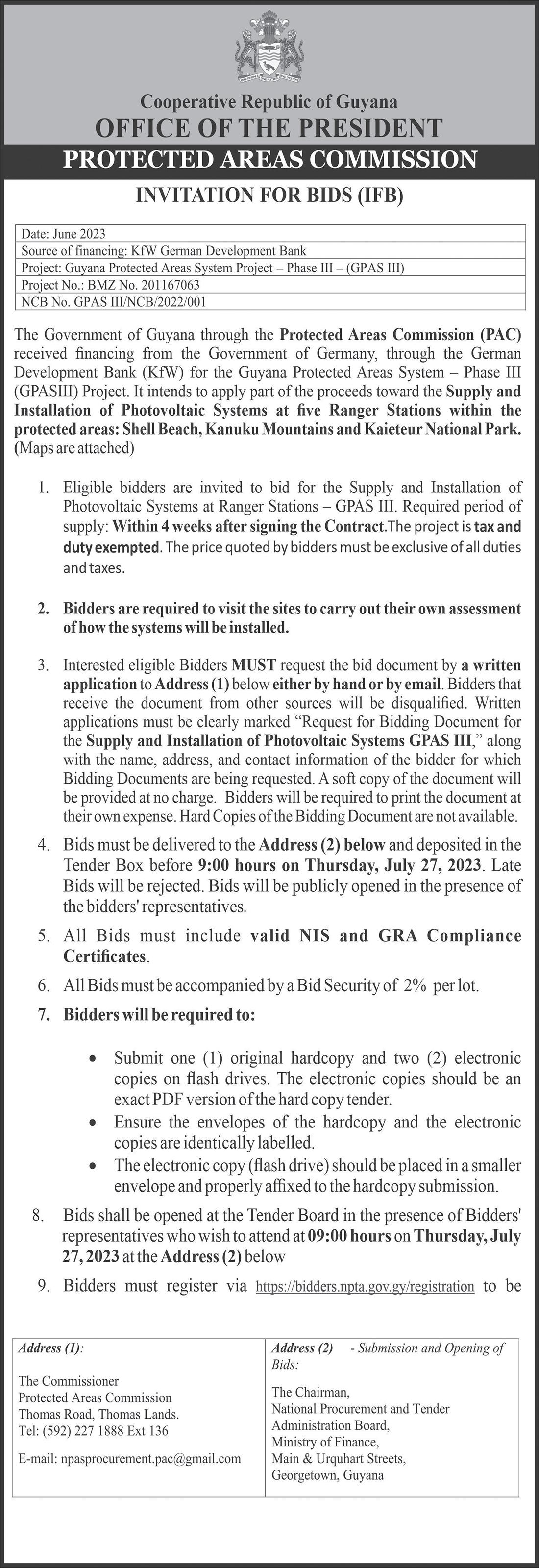
Editor, on an equally important front, GECOM is conducting countrywide Continuous Registration, which would put that institution in an excellent position to hold elections at any time. This exercise will ensure that the Register of Registrants will be adequately prepared and ready to extract a voters’ list for elections. The thorough preparation by GECOM for the holding of elections is most welcome, as it is a central pillar to ensure that our people’s democratic rights can be readily exercised.
Guyana is on the rise, and we must continue the most robust support for President Dr. Irfaan Ali, Vice President Dr. Bharrat Jagdeo, and the PPP/C team, who are in the process of providing better conditions for the nation.
Sincerely,
Neil Kumar
Now what is an ‘old dog’? I don’t want to get philosophical and equate the question with the one usually directed to humans (How old is old?) but we can use a rule of thumb and say that one dog year corresponds with seven human years.
‘older’ more quickly than their counterparts up North. Our climate, the lack of care and veterinary intervention, diseases, etc., do contribute to hastening Rover’s demise in Guyana. Yet, we have several regular visitors to the clinic which are well over 10 years of age.
cause of aging, I would receive the Noble Prize in Physiology and/or Medicine. We do know that aging is associated with a progressive and irreparable impairment of the functions of the body’s cells. Cells make up tissues, and tissues make up organs. The exact cause for the mal-
3 dog months = 5 human years
6 dog months = 10 human years
12 dog months = 15 human years
2 dog years = 21 human years
4 dog years = 32 human years
6 dog years = 40 human years
8 dog years = 48 human years
10 dog years = 56 human years
14 dog years = 72 human years
18 dog years = 91 human years
21 dog years = 106 human years
I should mention, though, that scientists do not like inexactitudes. A team of researchers at the Pennsylvania School of Veterinary Medicine has confirmed that a French veterinarian, Dr. A. De Beau, is much more accurate in creating an equivalency between dogs’ and human ages. It goes like this:
So keep in mind: Your pooch gets to be a senior citizen long before you do?
(Cats in Guyana tend to live much longer)

Dogs in Guyana may get
You see how I am trying to be ‘politically correct’ in my terminology even when relating to animals. I am no longer calling them ‘old’ dogs. I am using the word ‘elderly’. Just as in the case of humans, one should no longer say ‘old people’ rather the term is the elderly’, or better yet, ‘senior citizens’. I am told that in due course the word gurus will improve even on that description. Anyway, let’s talk about the aging process and the care associated therewith. If I knew the actual
function, over time, in the cellular chemistry and physics, is unknown. But you can be sure that many scientists around the world are studying this phenomenon. Of course, the studies are being carried out on animals, so we vets will probably be the first to know about any new breakthroughs; and we will be the first to implement the mechanisms which will ensure the longevity of our domesticated wards.
Factors influencing aging:
Notwithstanding the lack of scientific knowledge, it is clear even now that certain elements impact upon the longevity of an animal. Foremost among these are:
Genetics
Nutrition
Diseases
Environment
Tender Loving Care (TLC)
Let us briefly discuss these factors:
Genetics
Large dogs (e.g., German Shepherds, St. Bernards, Great Danes, etc.) seem to age quicker than smaller dogs (e.g., Dachshunds, Terriers, Spaniels, etc.). Even in the best kept households, the statistics show that dogs of the larger breeds reach an ‘old age’ at around 10 years, while the toy breeds exhibit old age
symptoms at a later age, 1416 years. And, for sure, we know that certain families (strains) within a breed live longer than other dogs of the same breed.
Nutrition

Some smart person has said that you are what you eat. Well, that wisdom is doubly true in dogdom. I am convinced that we curtail our pets’ lives by incorrect nutrition, whether by overfeeding or underfeeding. In our ‘love’ for our dogs we give them sweet treats,
tions) are taken. Dogs whose vaccination status and anti-parasitic schedules are kept up to date would surely live longer than those which are left unprotected.

Environment can mean many things, but I am referring here primarily to climate. We do live a few degrees away from the equator and, on the coast, below sea level. Consequently, the animals (like humans) live constantly under severe heat and humidity stress. If
spiced food - plenty and often. On the other hand, nutritional neglect results in ‘Rover’ being lucky if he gets three reasonably good meals a week. Neither of these two variations augur well for a long and healthy life of your pet. I should mention in passing that I once had a professor who advised that dogs should remain without food for one whole day every week. He maintained that the feeding regime should try as much as possible to imitate the feeding patterns of domesticated dogs’ cousins (e.g., wolves, foxes, etc.) in the wild who do not get food every day, yet fare well.
Well, obviously diseases like distemper, parvovirus, leptospirosis and hepatitis can wipe out entire litters and kennels, if no preventive measures (eg vaccina-
it is a long-haired dog, the discomfort is even more. The long hot dry season and the extensive rainy seasons with concomitant high humidity can actually weaken the animal. Of course, under such climatic conditions, many specific diseases proliferate.
The scientists have also determined that the tender loving care a dog receives within the household throughout its life is of great importance to its longevity. Again, statistics show that well-cared for pets succumb to less ailments during the course of their lives. The opposite is also true. If the pet is neglected, it is more likely to contract maladies which can accelerate the aging process. We will continue with this theme next week.
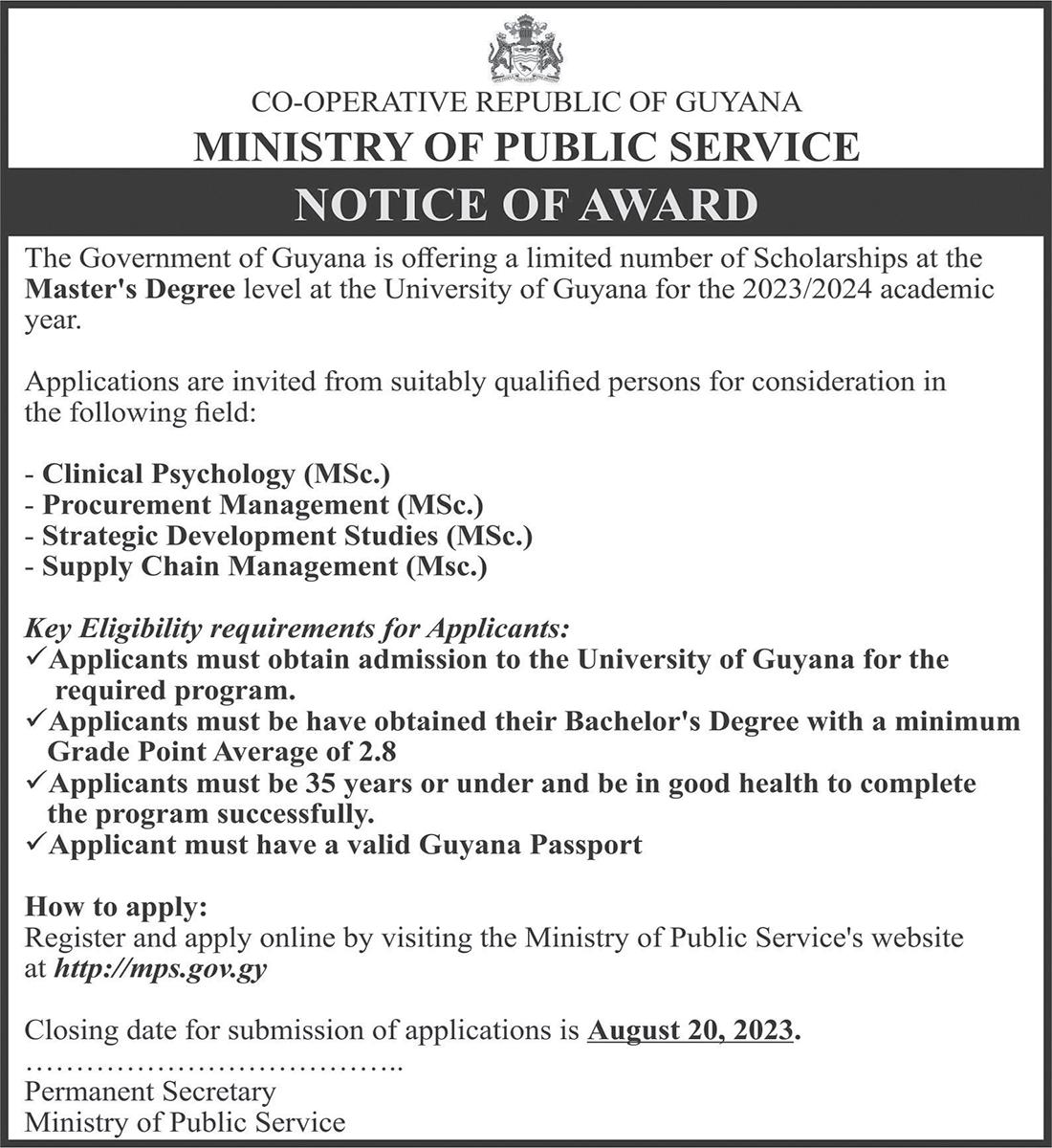
Atotal of 120 complaints were processed between 2021 and 2022 by the Ombudsman, ranging from complaints by a former Constable in the Guyana Police Force of sexual harassment, to the customary complaints of National insurance Scheme (NIS) payments not being remitted.

This is according to the Ombudsman’s Annual report of 2021-2022, which was recently laid in the National Assembly. In the report, it is revealed that of the 120 complaints, 54 were fully investigated and 10 are still being investigated.
Further, 66 complaints were determined to be outside of the jurisdiction of Ombudsman Justice (Retired) Winston Patterson. That jurisdiction includes departments of Government, certain corporations and statutory Boards.
However, 44 complaints were deemed to be justified and were resolved, while 14 were deemed unjustified, two were withdrawn, 10 are pending, five were referred and assistance was rendered in 25 cases.
Sexual assault
The cases the Ombudsman dealt with start with a complaint from a now ex-Constable of the Guyana Police Force (GPF), who the Ombudsman said was dismissed on the grounds “that having regards to the conditions of the Force and his useful-
ness as a Constable, such discharge is desirable in the public interest in accordance with… the Police Act Chapter 16:01.”
However, this Constable complained to the Ombudsman’s office of being shouted at and victimised while on the job and being locked up for 14 days in the barracks. He also complained to the Ombudsman’s office of being sexually harassed on the job, which caused him to lodge complaints to two Sergeants that were recorded in the location diary.
“On one occasion he had to rebuke an officer for his unmannerly behaviour and also recalled one of those unsavoury incidents which resulted in an argument between himself and a Constable in the presence of two other Constables and a Sergeant. The Constable made a serious allegation against him which was investigated. He appeared before a Superintendent and a Deputy Superintendent
who found that the allegation was unfounded and dismissed it,” the Ombudsman report states.
There was another instance the ex-Constable recounted, where he was late for reporting for duty. Despite explaining that the circumstances were beyond his control, he was confined to the barracks for seven days and given a drill complement, which he served.
“According to him he decided to seek my valued assistance in this matter. Allegations made in this complaint are very serious and senior and junior officers who were allegedly involved in wrong doings and sayings are mentioned by names and ranks. The complainant is even armed with a video to support his allegations.”
“I wrote the Commissioner of Police (COP) but received no reply. I sent him a reminder but got no communication from him. I eagerly await a reply from the COP. I do
not have jurisdiction over the COP… notwithstanding the above, out of courtesy, I should have been given a response to inform the complainant who I believe feels he has not been given justice in this matter,” the Ombudsman wrote.
Tellingly, the Ombudsman’s report contains a note commending agencies who did respond to his correspondence and cooperated with his office, including the Guyana Defence Force (GDF), Central Housing and Planning Authority (CH&PA) and the National Insurance Scheme (NIS). The Ombudsman went on to express hope that “other Government agencies will try to emulate them.”

NIS
Meanwhile, there are several cases involving the NIS documented in the Ombudsman report. In one case, a complainant who was formerly employed as an NIS inspector claimed to have been wrongfully dismissed, allegedly after he refused to carry out instructions from his local office supervisor that would have been a breach of procedure.
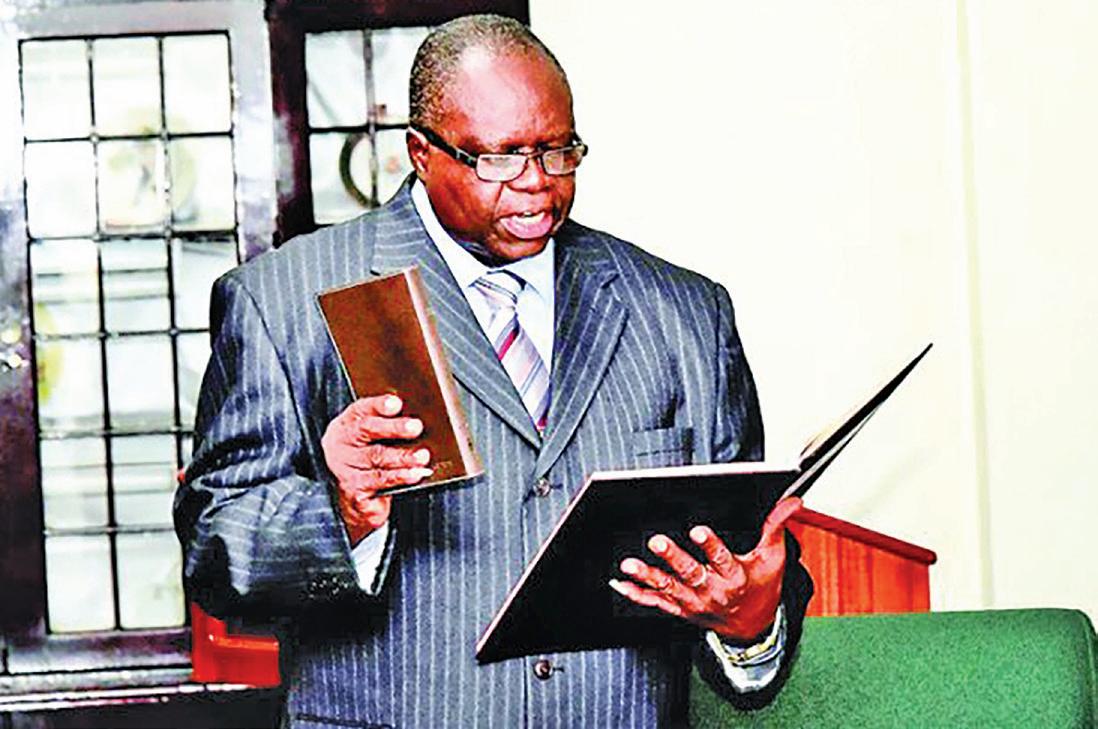
“The complainant’s matter was tabled before an internal committee of enquiry wherein he had a hearing and the NIS Board at its meeting decided that he should be dismissed with immediate effect. The scheme paid the complainant all his entitled benefits. Complainant was given adequate notice,
attended and represented himself at the hearing. This complaint has no merit and he was accordingly informed,” the Ombudsman wrote.
In another case, a 63-year-old father and grandfather, the sole breadwinner of his family, had complained that after working with a firm for over 13 years, no money was ever remitted to the NIS despite deductions from his salary.
“I wrote the NIS enclosing statements showing that the complainant worked during the period mentioned. Within one
month, NIS responded that there was need for further investigation. An update three weeks thereafter informed that the appeal was being processed. After not receiving a further update, a reminder was sent to NIS.”
“Finally, three months after being reminded, NIS responded confirming that the insured person, the complainant, is in receipt of his pension. The complainant was relieved and expressed thanks and gratitude to the Ombudsman’s office and the NIS,” the Ombudsman wrote in his report. (G3)
The Radiation Safety and Security Bill 2022, which was recently passed in the National Assembly, now outlines penalties for corporate bodies in breach of the legislation, ranging from $5 million to not more than $20 million.
Under the framework, any person who contravenes any of the provisions under the Act for which no penalty is specifically provided, is liable on summary conviction to a fine of not less than $1 million nor more than $10 million dollars or imprisonment for a term not exceeding three years.

Where a body corporate or its director, manager, secretary, agent or any other officer concerned with the management has been convicted of an offence, the court shall have the power to also revoke any licence issued pursuant to the Bill.
It can also forfeit all property to the State, including money, valuables and other movable and immovable property, of a person convicted of an offence, that was used or intended to be used, or was obtained in the course of the crime, or as part of benefits gained from the crime.
The new legislation states, “Where a person is convicted of an offence under this act or the regulations, if the contravention in respect which the person was convicted is continued after the person was convicted, the person shall be guilty
of a further offence and liable on conviction to a further fine of one-fifth of the maximum penalty.”
This is the first time in the country’s history that legislation has been enacted to govern ionising radiation use, which Dr Anthony labelled as a ‘landmark’ move to keep people safe.
To ensure the objectives of this Bill are realised, it provides for establishment of a Radiation Safety and Security Board. This Board, as an independent regulatory authority, is mandated to work with relevant Government agencies to ensure that activities and practices involving the uses of ionising radiation and nuclear energy are used in Guyana for only peaceful purposes.
Health Minister, Dr Frank Anthony told the National Assembly during the most recent sitting, “Once this Board is constituted, if there is any use of radioactive material, if can be governed by the Bill. I
think adequate provisions have been made and we are working to put the right legislative environment in place.”
The Bill recognises that the use of ionising radiation can provide important benefits in many fields, including health and medicine, energy production, scientific research, agriculture, industry and education.

However, it was also recognised that it is equally important to establish measures to protect individuals, society and the environment from the potentially harmful effects of ionising radiation, including those that can result from improper use, accidents or malicious acts.
Any person who intends to engage in an activity other than the mining of uranium or thorium are required to notify the Board of its intention to carry out such, and within seven days, the Board shall decide whether the proposed practice requires a licence.
Where it is an application for a possession licence, the applicant might be required to submit a radiation safety plan or nuclear security plan.

Opposition Member of Parliament, Tabitha SaraboHalley opined, “Though the Board will be constituted to deal with radiation and radioactive matters, it is my hope that when the Bill passes and is assented to,
efforts will made to operationalise all elements of this particular Bill. Because it is one thing to say it is a good Bill and to pass it but operationalising it is a different story.”
Minister of Human Services, Dr Vindhya Persaud told the House as she rose to support the Bill on Thursday, “It is so important that when people apply for licensing, they are able to withstand scrutiny to adhere to what is requested by the Bill, and also, at all times to maintain safety of the environment and people working within their entity, or other people who may be exposed to this kind of radiation.”
Meanwhile, in respect to radioactive waste, the Board in consultation with the Environmental Protection Agency and Local Government Ministry is responsible for developing a national policy and strategies for management under Cabinet’s approval.
It states that people and the environment should be adequately protected against radiological hazards; that generation of radioactive waste is kept at the minimum practicable; protective measures are implemented to reflect international criteria; residual heat generated during waste management is addressed; and that such activities be properly regulated. (G12)
Your Eyewitness was accused of not being “woke” enough!! Now that the word “woke” was officially added into the Oxford English Dictionary as an adjective only in June 2017. Just two years before, the hip Urban Dictionary had defined it thusly: “being woke means being aware… knowing what’s going on in the community (related to racism and social injustice)”. But, decades before, it was part of the street talk of Black America (like “hip”!) in Harlem. It hit wider America when the NY Times mentioned it in 1962. So, the word comes out of the Civil Rights struggle in the USA, a’ight??

In 1972, this connection was made explicit when a character in the play “Garvey Lives!” said: “I been sleeping all my life. And now that Mr Garvey done woke me up, I’m gon stay woke. And I’m gon’ help him wake up other black folk”. Since then, the word has expanded its reach into the wider world: oppression knows no boundaries - along race, colour, sex, gender, age, ethnicity, origins, etc.
So, being “woke” is to be aware of who’s stepping on whom - and accepting that we gotta stand on the side of the oppressed. The question is who decides who’s oppressed!! Of recent, the word’s been given an ironic twist, suggesting that some folks place themselves on pedestals, from where they can sneer down on otherswho aren’t as “woke” as they. So, how’s this playing out in Guyana? We would’ve noticed that the words “racial” and “racist” are being thrown around with abandon nowadays - especially before and after our elections.
Is it that the folks bandying those terms are more “woke” than others - insisting there’s more in the (social) mortar than the pestle (of race)? Or is it they’re just exploiting the term wrenched from its American roots? So, we gotta be jive to be woke?? Just listen to those Opposition talking heads on social media and you’d be forgiven for thinking you were in deep Alabama!! And folks with pointy hoods were burning crosses on your bridge!!
Anyhow, your Eyewitness’s take on the local usage is: there’s nothing “woke” about anyone suggesting we have an “apartheid” state in Guyana. That’s just insulting South African Blacks, who had to follow laws that explicitly defined them as lesser human beings. Ironically, when Burnham sanctimoniously offered monetary help to fight apartheid in South Africa, he was oppressing Indian Guyanese in Guyana on the basis of race!! Who was oppressing who then? Wasn’t THAT more of an apartheid state?? Or is it that only one sort of folks can be woke??
So, what’s next? We gotta all be singing kumbaya to be called woke?? Or just cussing out the PPP will do??
…delaying Congress?
Diddling with Congress has a long lineage in the PNC. In fact, it goes back to even before there was a PNC, when Burnham was intent of seizing control of the PPP from the leader, Jagan! The man actually surreptitiously organized one Congress without even inviting Jagan and the PPP executives, who stood by the party’s rules!! Anyhow, Burnham was forced to eventually concede defeat, and slinked off to form the PNC?
But he never gave up his tactic of fixing Congress Meetings to fix who was in and who was out. So, it shouldn’t come as a surprise that the incumbent leader might be using the same modus operandi to stave off the challenges to his leadership. The man had accused his predecessor of doing the dirty back in 2011, and that rift never healed. So, the incumbent might be thinking “do fuh do na obeah”!!
But as a fella who doesn’t think, but just remembers, don’t hold your breath waiting for Congress.
You might just croak.
…afraid of elections?
But it ain’t just party elections that’s causing consternation in the Opposition camp. There’s the General Elections staring them in the face for 2025. It can’t be easy knowing you might be in the wilderness for another 23 years!!







In the Local Government Elections (LGE) held last month, the PPP claimed they made “significant inroads in PNC strongholds” – read communities dominated by African-Guyanese. The PNC, on the other hand, disputed the significance of any such shift by insisting it was “bought” through massive spending –direct and indirect - in those areas by the PPP government. They predicted the shifts would be transitory, since LGEs are not seen as deciding who governs, and would be irrelevant in the upcoming 2025 General Elections.

 Ravi Dev
Ravi Dev

While all incumbent governments use their access to the treasury to court voters, in my estimation, the acceptance of the ethnic/racial nature of the voting blocks to be courted by both major parties is a major step forward out of our political logjam. Their insistence, from the beginning of modern politics here, that they were “multi ethnic/ racial” was, of course, an implicit acceptance of our social reality. But their further explication that they were blind to racial/ethnic divisions in their policies and actions led to persistent assertions of ethnic/racial discrimination and broad cynicism.

Guyanese elections since 1957 have been categorised – not unfairly – as ethnic censuses, and most Guyanese ruefully shake their heads when alluding to this reality, and wistfully wish, “If only…” Elections are seen as reinforcing our “divisions”, which become flashpoints for ethnic violence. We have been insisting that unless we address the reason for our voting behaviour, our tensions would remain entrenched.
One such reason was proposed by the African-American scholar Michael Dawson, who explained African-American voting behaviour as the logic of “linked fate”. If circumstances, whether systemic or planned, affect a particular set of people specifically and consistently, it is only “reasonable” that it will dawn on them to react similarly to whatever power that determines their fate. And a “group-in-itself” (a statistical category) becomes a self-conscious “group-for-itself”, because of their lived experience.
Historically, our fates were very early on linked to our ethnicity by the differential treatment meted out by the British. Amerindians were allowed to sink back into the “interior”; Africans were enslaved, and then “emancipated” with new mental chains; indentured Indian sugar workers were “ruralised”; while Portuguese and Chinese indentureds were facilitated to carve a niche in the urban and rural retail sector to service a cash economy. It soon didn’t matter whether there were 9 tribes of Amerindians; dozens of tribes from West Africa or North and South Indians: each of those groups coalesced separately, primarily because of their separate linked fates.
With the coming of “democracy”, to allow control of the state through the agglomeration of numbers, the politicians merely followed the ethnic logic and organized along group identities that had already been created. Jagan’s carefully constructed PPP of 1950 was a self-conscious “ethnic coalition”: Ashton Chase stepped aside for the more popular “African-Guyanese” Burnham. The ethnicallychannelled political struggle precipitated by Burnham’s departure, however, led to its own problematic that we called our “ethnic security dilemmas”. For the longest, the majority Indian-Guyanese felt that even if they won “democratic elections” at the ballot boxes, they faced an existential threat to their physical security. AfricanGuyanese, on the other hand, felt that because of their minority status, their well-being was always going to be at the mercy of the not necessarily benevolent majority.
Following independence, “discrimination” became a fact of life following Burnham’s drive to empower himself and AfricanGuyanese. Whether that discrimination was “racial”, as Dr Jagan accused, or “political”, as Mr Burnham retorted in 1977, or was irrelevant. But with the demographics now creating a nation of minorities, and the African security dilemma resolved, after acceding to office with the assistance of AFC’s Indian-Guyanese votes in 2015, it was an act of political madness for David Granger to fire 7000 mainly Indian-Guyanese sugar workers. On the other hand, it should be considered a positive exercise of political logic for the PPP to actively court both African and Indigenous Guyanese to agglomerate a majority in our democratic polity.
However, the Indian-Guyanese Security Dilemma occasioned by the African-Guyanese domination of the state bureaucracy and armed forces must be addressed openly. The PPP must also issue ethnic impact statements to demonstrate that their policies create equal opportunities in all areas of national life for all ethnic groups, to unlink fates to ethnicity. It should be noted, however, that equality of opportunity does not necessarily translate into equality of outcome, which ultimately depends on individual initiative.


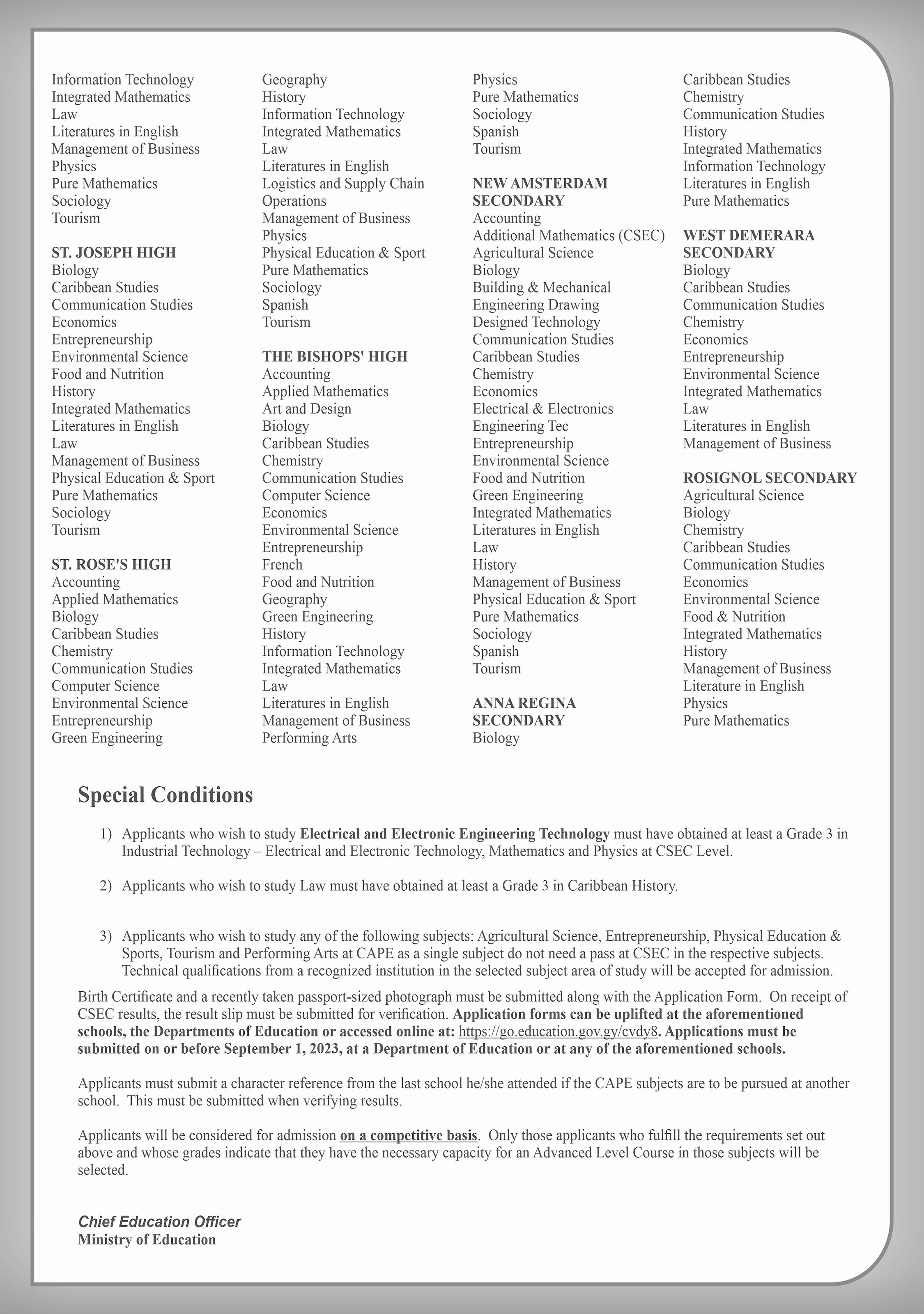
In 2011, Amar Bacchus was in front of a chalkboard, teaching students when he and a friend thought of establishing their own school. At the time, he was giving extra mathematics lessons to several students. Eventually, more than a dozen students joined the lessons, and the duo rented the downstairs of a property to teach their growing class of extra-lessons students.
Bacchus and his friend subsequently parted ways by mutual agreement, but he continued to teach grades seven to nine students. Eventually, in 2018, Bacchus and his wife Alexis converted the idea into reality by establishing their own school, Bacchus Learning Centre.
Sadly, his wife Alexis succumbed to cancer earlier this year, but the ambitious Bacchus continues to robustly establish the school and realise the dreams he and his wife had while embarking on a mission to establish a highly modern smart school.
Today, the school, located in Pike Street Campbellville, Georgetown, is unique in its method of teaching, offering its students online and face-toface classes through innovative modes of technology. The school’s learning content is delivered to the students through structured “hybrid” methods of learning, or what Bacchus has termed “smart methods of learning.”
During a sit-down with Guyana Times last week, Bacchus said the school offers classes at all levels: from the Alexis “B” Nursery and Playgroup through to the primary and secondary divisions. The school also offers Caribbean Secondary Education Certificate (CSEC) classes to adults, giving them a second chance at enhancing their qualifications; and foreign language classes through the Alexis “B” Fluent Language programme. Spanish, Portuguese and French are taught through this programme.
Smart classrooms
Bacchus noted that when the pandemic struck the health care system in Guyana, he and his wife had to find alternative methods to teach their students and to keep the institution operational. At the time, the student population of the school was close to 100, but the disease caused that number to dwindle to 25. He said the Ministry of Education was then pushing the smart-classroom concept, and immediately he decided to adopt this concept of teaching.
“We were trying to teach via WhatsApp, but it was not working,” Bacchus said.
The school then utilized the Zoom-app, but that also proved difficult. “At first it was difficult because we did not understand the dynamics of Zoom, so we didn’t know when to mute students, and everybody kept talking,” he said, adding that it was chaotic. He posited that the students were excited to see their colleagues after many months, and may have been eager to talk to each other rather than completing their schoolwork.
As time progressed, he and his staff studied the use of the Zoom platform extensively, and the school implemented “certain strategies to manage the students’ behaviour, even using methods to get them to respond when asked questions.”

The student population was again growing, and parents were contacting the school to enroll their children, while others, whose children attended school prior to the pandemic, were also in contact with the school.
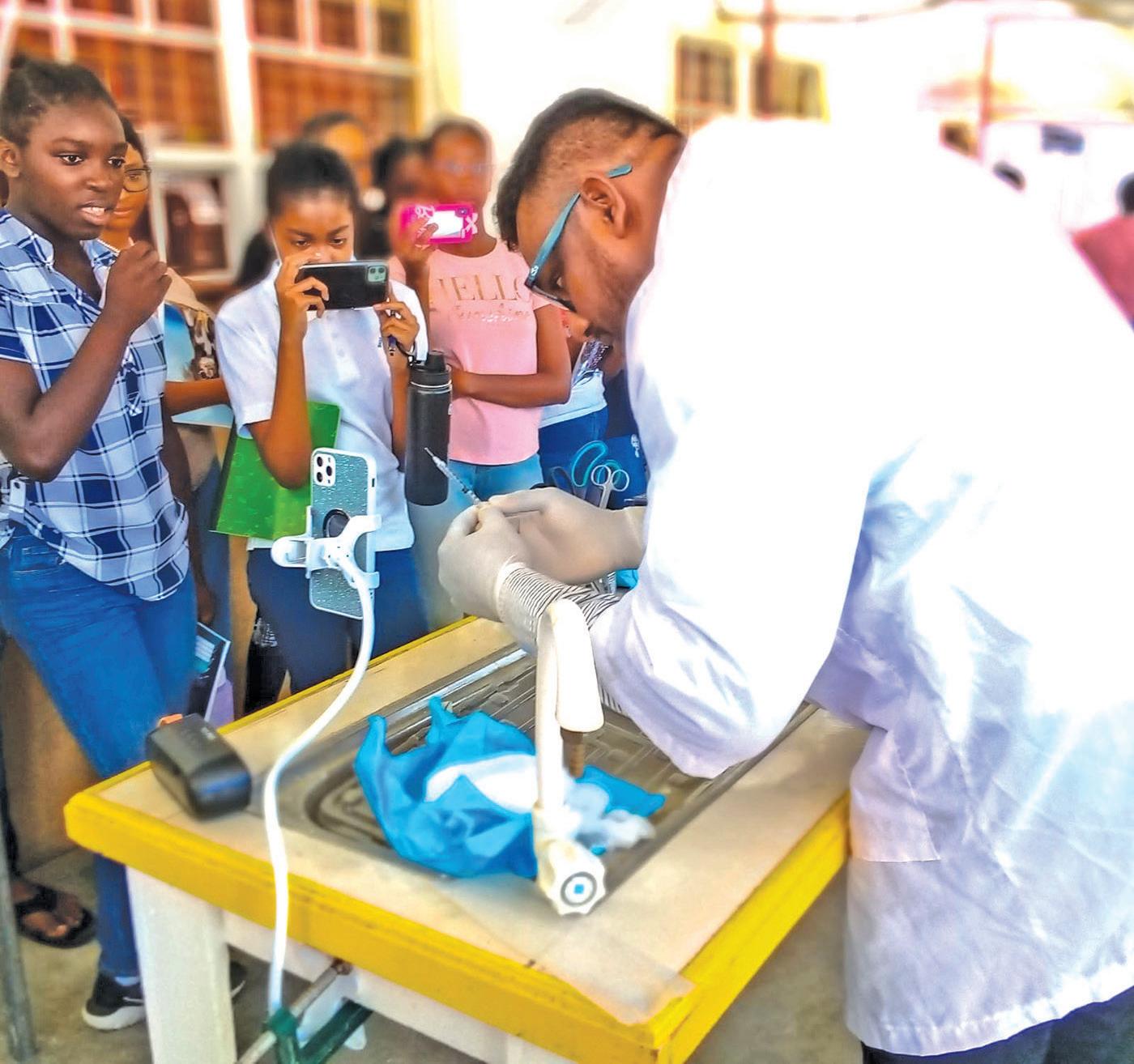
“We now had to restructure
our timetable, get back our staff, and set a better schedule,” he explained.
His wife Alexis ran the school daily, while Bacchus provided support and ensured that the computerized systems within the school were up and running. Students from various parts of the country enrolled at the school, and Bacchus noted that the population of the school had now grown past 100.
“Today I can say that the pandemic has been a blessing to some and a disaster to some, but for Bacchus Learning Centre, it has been a blessing, because today we are able to now have a hybrid method of teaching. We had to learn the dynamics of online teaching, that today we still utilize that method, so all teaching goes through the Zoom app,” he said.
He said students have an option of attending school in person or online, especially in the event of emergencies.
“Parents can choose whether they want their child to come to school some days physically or attend via online. Parents are able to better monitor their child’s performances for those who choose online, because they can see what is being taught and the amount of work taught,” Bacchus said.
He said the school created WhatsApp groups for each class, and parents and students who are in the groups are notified when classes are in session. A snapshot of the attendance of students who are attending school online is also sent to the groups so that the parents can be aware of their child’s attendance while at home.
“It took time to develop this method, but we are growing because, only two days ago, we met with a Trinidadian smart tech company because they want to collaborate with us to implement smart boards in the classroom. So… our classrooms will be enhanced using technology,” he added.
No chalkboard
Bacchus explained that the teachers have been trained to teach students online and those in the classroom using the Zoom app. He said cables are connected to each classroom, and a large television screen takes the place of a chalkboard. The teacher sits in front of the class and teaches the students using the computer and a touchpad.
In place of the chalkboard, the teacher utilises the computerized writing pad to make notes or write instructions for the students to follow the lesson. Those students who are attending online from home would view the class in session via their phones or laptops.
Bacchus said microphones and other gadgets are utilized by teachers to carry out their instructional period. He said this “hybrid” method allows learning to be “much more diverse.”
He said in a normal classroom, a teacher would utilize a considerable number of minutes to draw a diagram on the chalkboard before he/she can explain it to the class. “Now I can project that same diagram on the screen for everyone in the class to see within seconds, and I can take that 20 to 15 minutes to do much explanation, more reinforcement, and also have more discussion among the students,” he said.
“In my view, using the traditional method of teaching, while I would take five days to get a concept over, in the modern smarttech method which we utilize at the school, I can get that concept over to the students in a day,” he added. The concepts are augmented by utilizing videos, slides and realistic photographs for his students.
As an example, he explained that during one of the ongoing summer classes, the science students were participating in the dissecting of a frog. He said he obtained the assistance of a doctor, who joined online, and while the frog was being dissected, the medical professional was explaining what was happening, and he also shared his knowledge on various aspects of surgical practices.
Attendance register Bacchus explained that, on a normal day, 10 to 15 students would be in the classroom in person, while 10 may be attending online. He said this eases the burden the parents may have to face in sending their children to school in the face of an emergency, or because of various circumstances on a school day.
“A parent may wake up one day and realise he/she doesn’t have (money) to spend on that day to send the child to school so. They will say, ‘Let’s do online today’,” he said with a smile.
Bacchus said that, as per tradition, an attendance register is kept for students attending school daily in person. For those online, the teacher keeps a record of those students who are attending. “Teachers also have to keep their record for the Ministry of Education purposes, so we still inculcate tradition with modern,” he said.
He said all the work taught by the school is backed up to a server. This, he noted, would be helpful to students who may have lost their notebooks from previous months’ classes.
Achanging environment in addressing mental health patients has led to new positions on treatment.
Health Minister, Dr Frank Anthony has positioned that in keeping with this, patients should not be institutionalised for a long period of time, but rather, be treated and discharged.

He was speaking on mental health as a public safety issue on Friday during a Guyana Police Force symposium at the Police Officers’ Mess Annexe.
The symposium was held under the theme, “Improving Police Performance Through Stakeholder's Approach”.
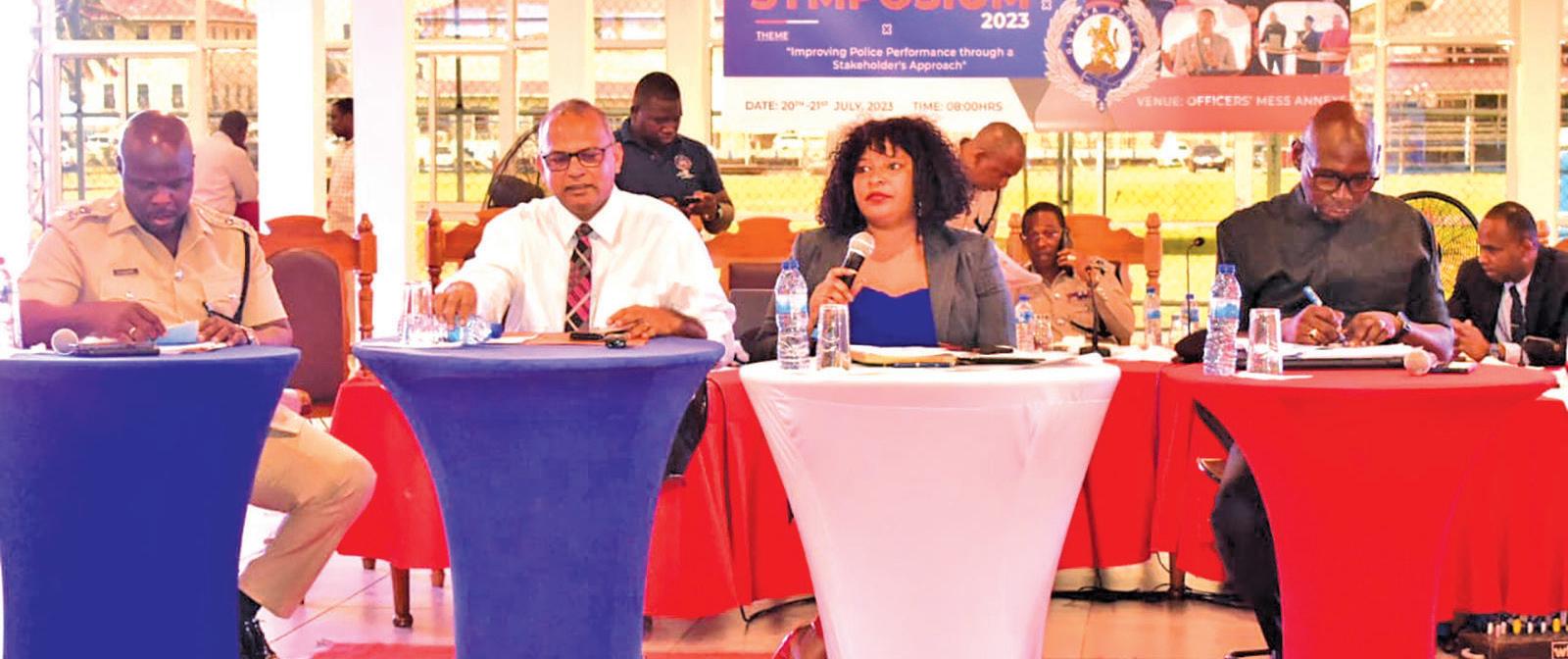
Dr Anthony said the mental health legislation has been upgraded to adopt modern mental health practices.
"How we practice psychiatry now is much different from the way we did years ago. Today, our job is not to keep people institutionalised; the idea is to treat and return patients to their homes," he outlined.
The Minister disclosed that modern psychology sees acute episodes in patients, which when treated caused stabilisation resulting in a timely return of patients to their families.
"We are no longer keeping patients for an extensive time
in our institution. The practice of psychiatry is changing, and these are the international norms we are embracing and adopting in Guyana.”
One in every eight persons globally experiences a mental health disorder. With mental health disorders containing 22 categories, he said that anxiety, depression and neuro-developmental disorders are most prominent in Guyana.
In addition, Minister Anthony made mention of training programmes that are available through the World Health Organisation (WHO) to better improve mental health practices. The Ministry is equipped with 16 psychiatrists, and a post-graduate programme providing training to psychiatrists as they respond to the needs of patients.
"We also have two child psychiatrists, and a forensic psychiatrist who can respond to legal issues," he added.
With mental health as a global concern, the Ministry of Health is looking towards extensive collaborations with the Guyana Police Force shortly, to provide training and support in dealing with persons with mental health disorders.
As of September 2022, the Mental Health Protection and Promotion Act has been in effect.
Enshrined in the law is a series of rights for mental health patients, including access to care.
The Act provides for the mental health care of persons suffering from mental illness and protects, promotes and fulfils the rights of those persons during the delivery of mental health care. Additionally, it seeks to promote the mental health and well-being of persons in Guyana and to ensure that all persons receive the best mental health care.
When the Bill was tabled in the National Assembly, it provided for the setting up of a Mental Health Board, while repealing the mental hospital ordinance.
When the Bill was passed, Dr Anthony had labelled the legislation as a modern one that would positively impact the level of care for persons suffering from mental health issues. While the traditional method of addressing mental health patients was to institutionalise them, the Health Minister had positioned that this way does not allow for them to be integrated into society.
The modern way is to manage them without such harsh restrictions, and the Act now lays the foundation for Guyana to implement such. (G12)
Non-governmental organisation (NGO), ChildLinK in partnership with the United Nations Population Fund (UNFPA) on Wednesday launched the National Adolescent Sexual Reproductive Health and Rights Essay Writing, Art and Spoken Word competition.
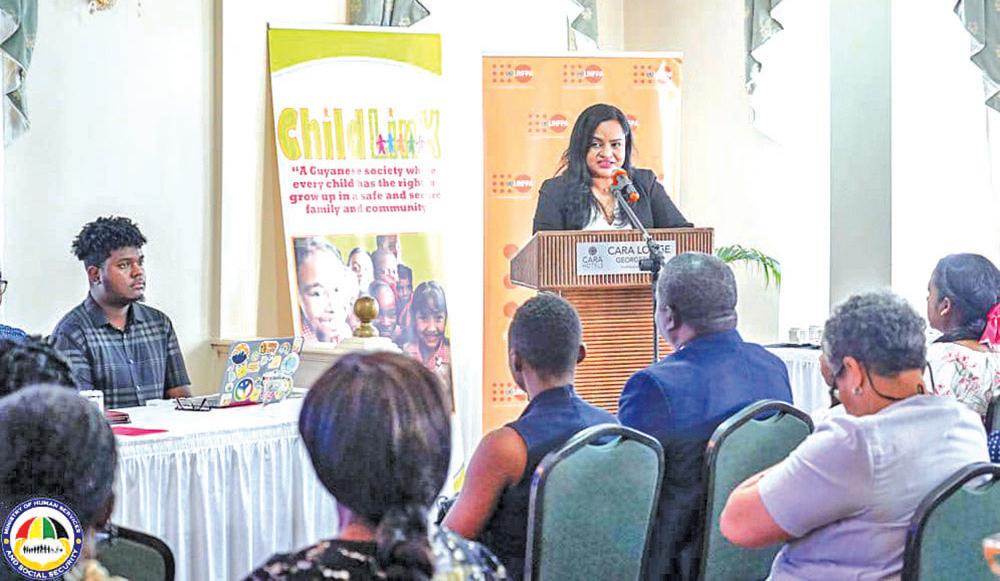
Themed "What Behaviours and Practices of Adolescents, Particularly Adolescent Boys, Would Contribute to Adolescent Sexual and Reproductive Health and Rights in Guyana?” this initiative aims to give Guyanese youths a platform to discuss their rights and note better sexual health practices.
Open to young people between the ages of 12 and 18 years, the competition runs until September 7.
Human Services and Social Security Minister Dr Vindhya Persaud, during the launch at Cara Lodge, Georgetown, commended the initiative and acknowledged the opportunity it
gives to young people in having their voices heard.
“This is an important subject matter and the passion was evident in what was said during the launch,” Persaud said.
Persaud added her hope for youths to utilise the opportunity to express themselves, while expressing that she looks forward to reading, listening and
seeing their creativity.
Also in attendance were UNFPA Liaison Officer, Adler Bynoe; Head of Office of the UNHCR Guyana Office and Acting UN Resident Coordinator in Guyana, Henri Sylvain Yakara; ChildLinK's Managing Director, Omattie Madray; and guest speaker and fashion designer Randy Madray.

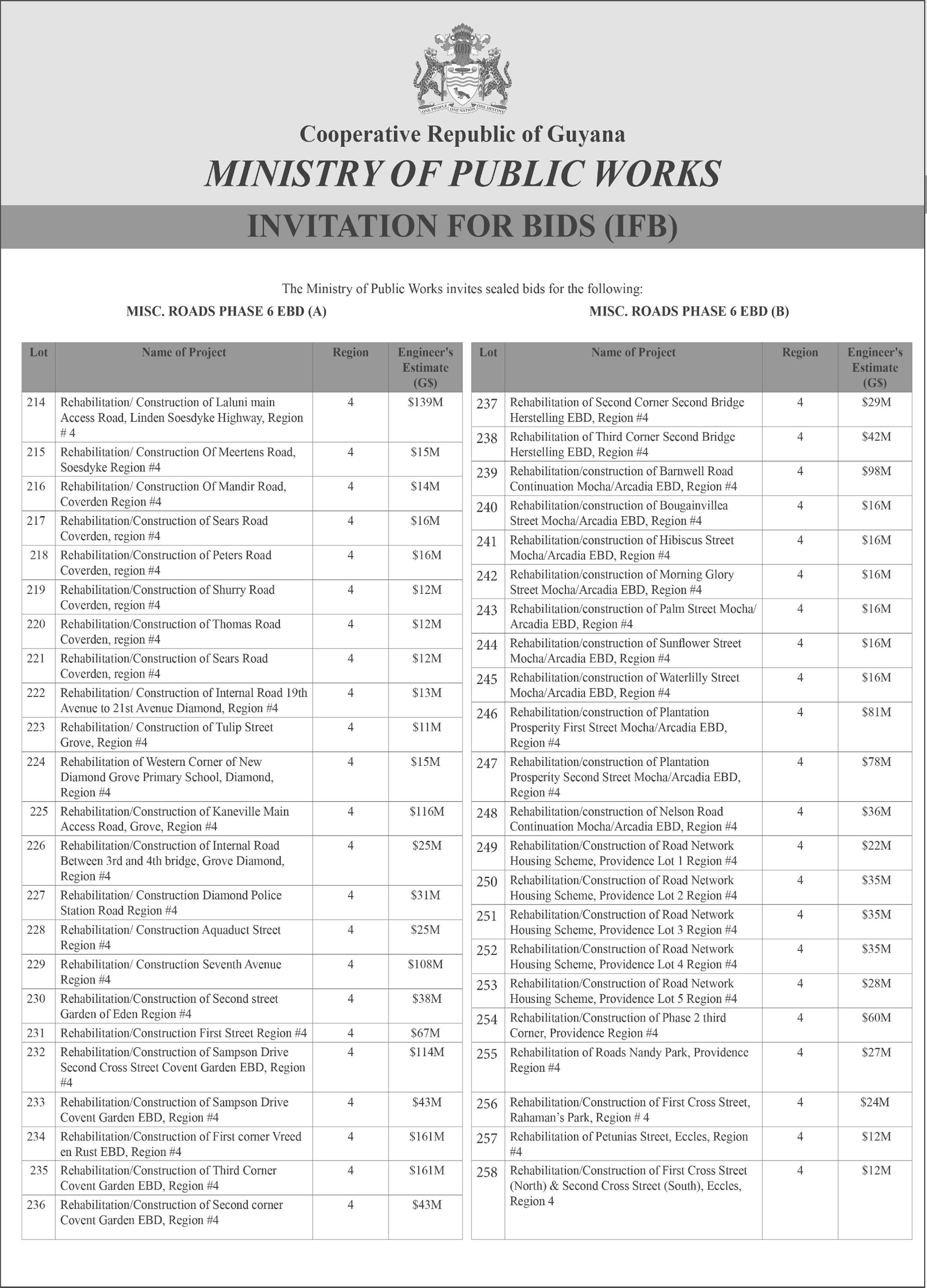


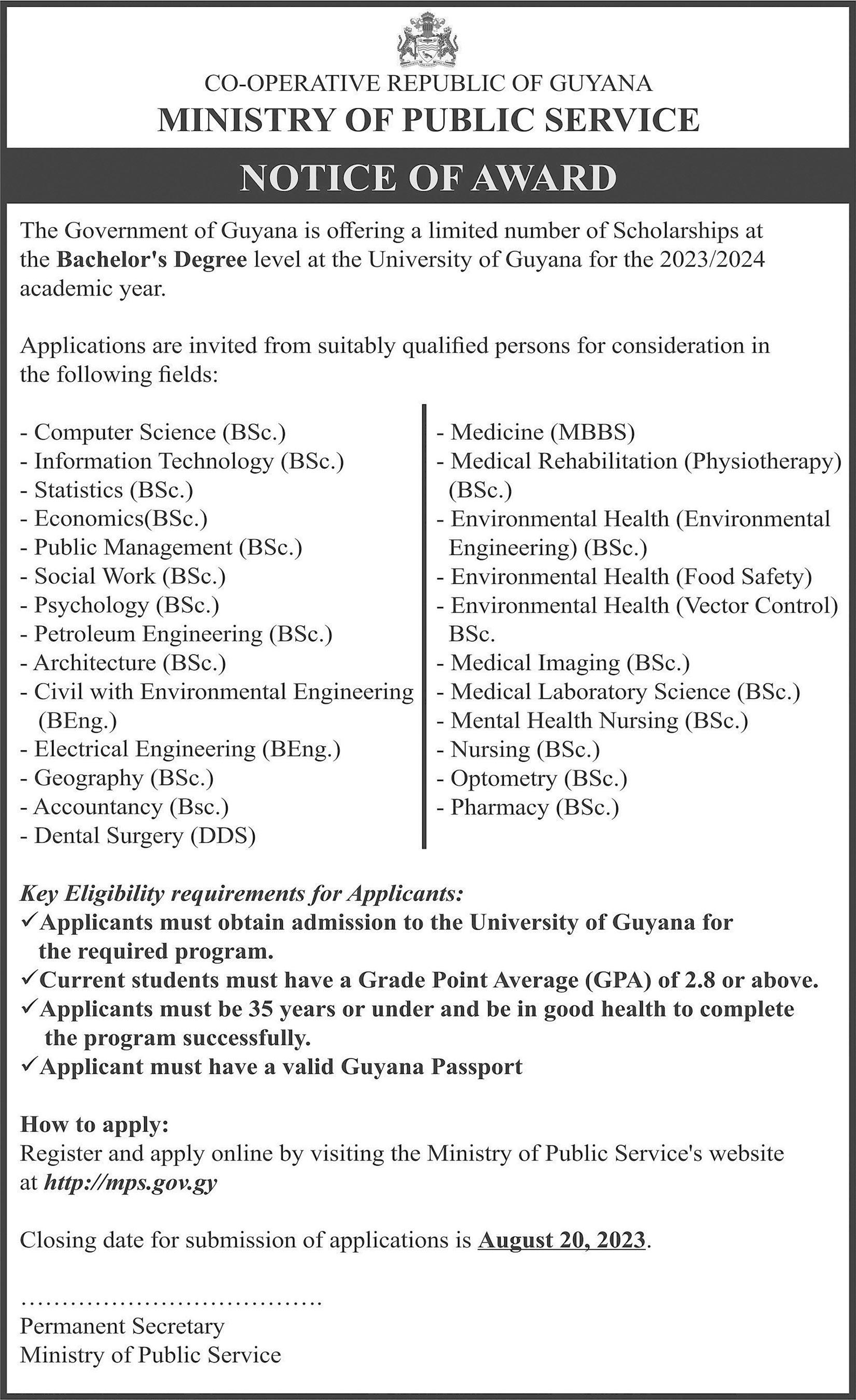



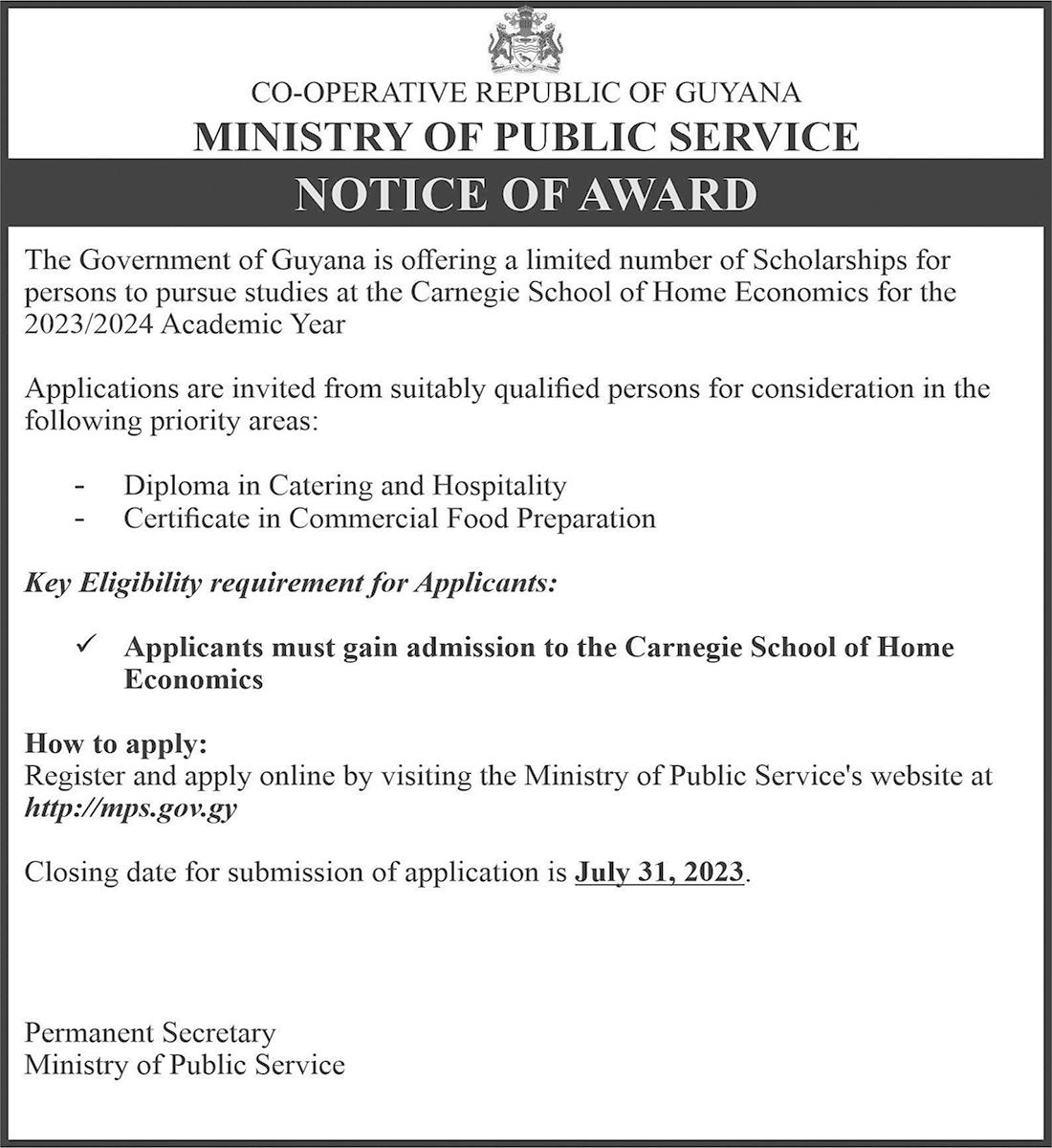
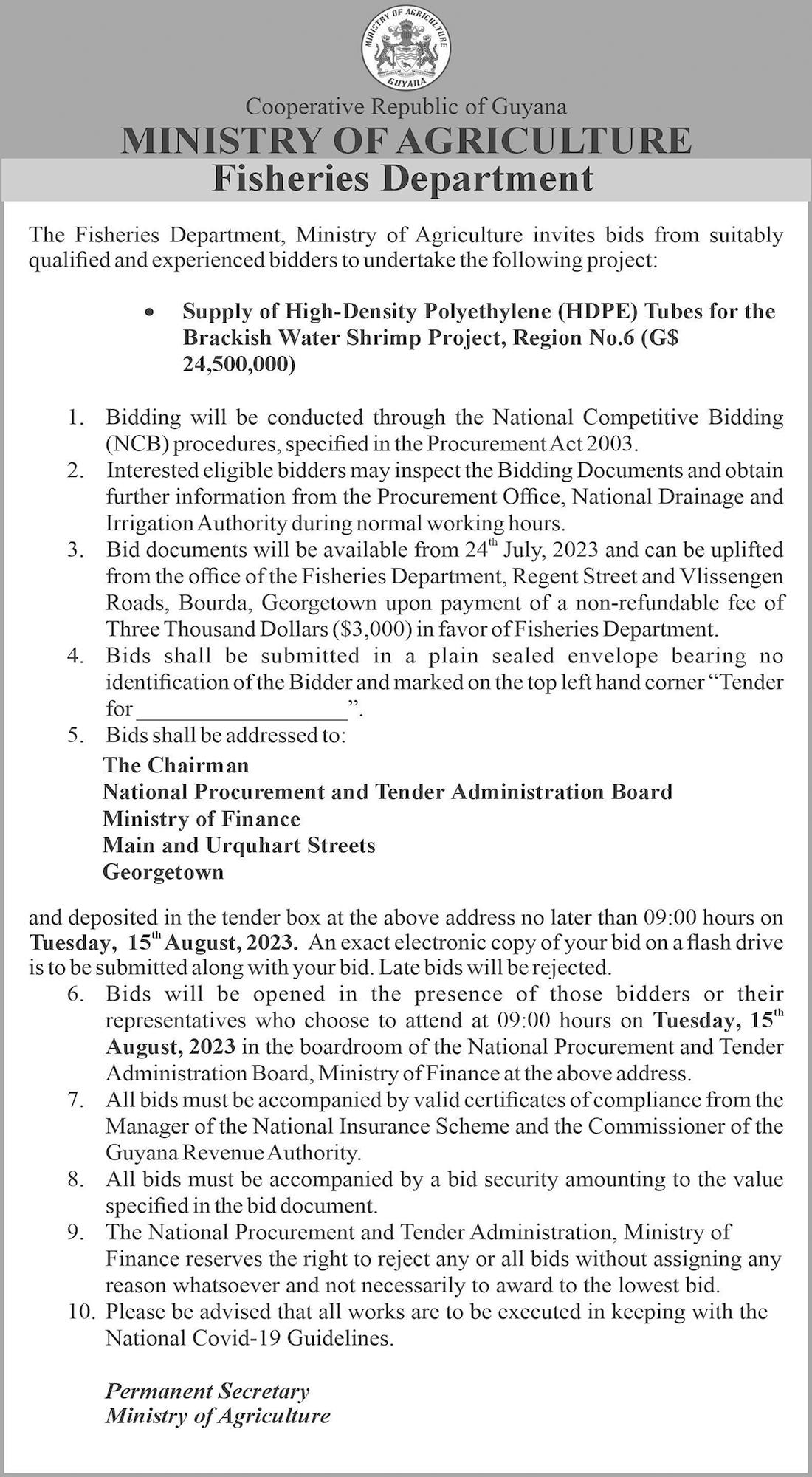


The elderly population has been encouraged to, at least once a year, undergo a holistic check-up as the Health Ministry seeks to offer preventative care before illnesses develop.
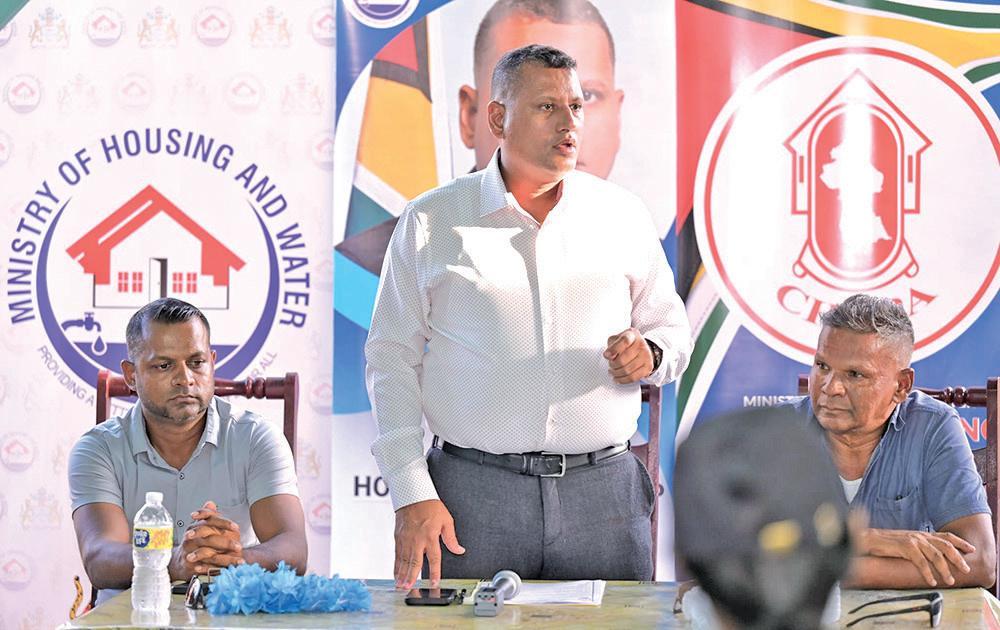
The Health Ministry, under the Elderly Health Programme, focuses on the areas of care for the older population.
Coordinator of the Elderly Health Unit, Dr Melissa Dehaarte outlined that at the primary healthcare level, resources are available for physical checkups and screening for hypertension and other chronic conditions. If services such as physical rehabilitation or surgical intervention is required, they will be referred to a hospital or specialised facility.
“We want to cover the preventative aspect of ageing before someone becomes sick and even when they’re ill, to have care. They can visit any local health centre and inquire about what is needed for elderly persons. Even if the person is not sick, they should have a check-up at least every year,” the coordinator outlined.
One of the areas which the Ministry is heavily focused on is prevention. There has been a trend where chronic illnesses are
detected at a very late stage. Once a diagnosis is made, that person can join the local clinic and be assessed routinely. “I do not recommend staying home and buying medication over the counter. Many persons do that. It is important to be a member of a health centre because they will have all the drugs you need, the medication so you may not have to expense yourself because medications are free through the Government’s health sys-
tem.”
If a person is on medication, Dr Dehaarte encouraged that they should undergo a blood test every six months.
She detailed, “We are working along with non-governmental and religious organisations to have what we call elderly clinics within the different regions. So, this may range from a specific day set aside just for the elderly…What we’re now having is a more integrated look and assessment tools being
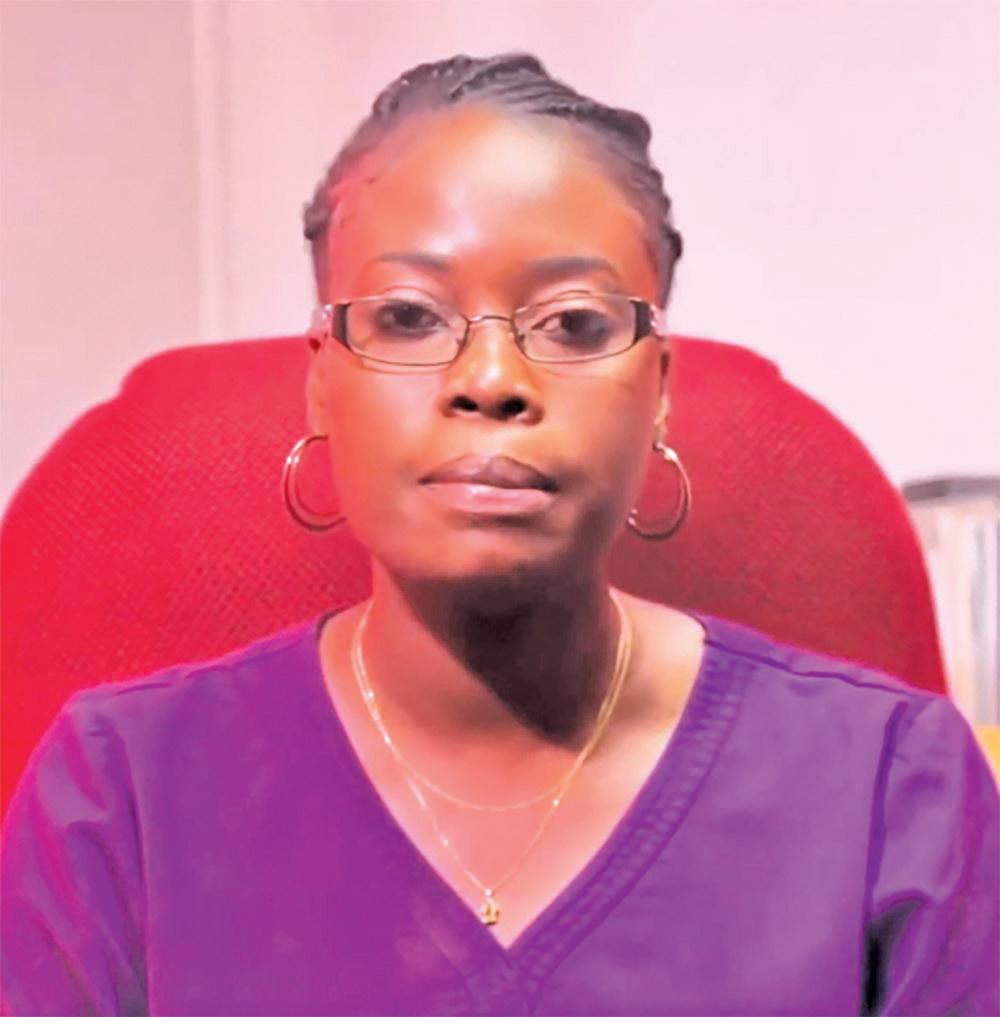
provided to our workers for them to zone in on mental issues such as Alzheimer’s, forgetfulness and all other degenerative issues that might happen.”
Common conditions in older age include hearing loss, cataracts and refractive errors, back and neck pain and osteoarthritis, chronic obstructive pulmonary disease, diabetes, depression
and dementia.
The World Health Organisation (WHO) notes that as people age, they are more likely to experience several conditions at the same time.
It also suggests, “Although some of the variations in older people’s health are genetic, most is due to people’s physical and social environments
– including their homes, neighbourhoods, and communities, as well as their personal characteristics –such as their sex, ethnicity, or socioeconomic status. The environments that people live in as children – or even as developing foetuses – combined with their personal characteristics, have long-term effects on how they age.” (G12)
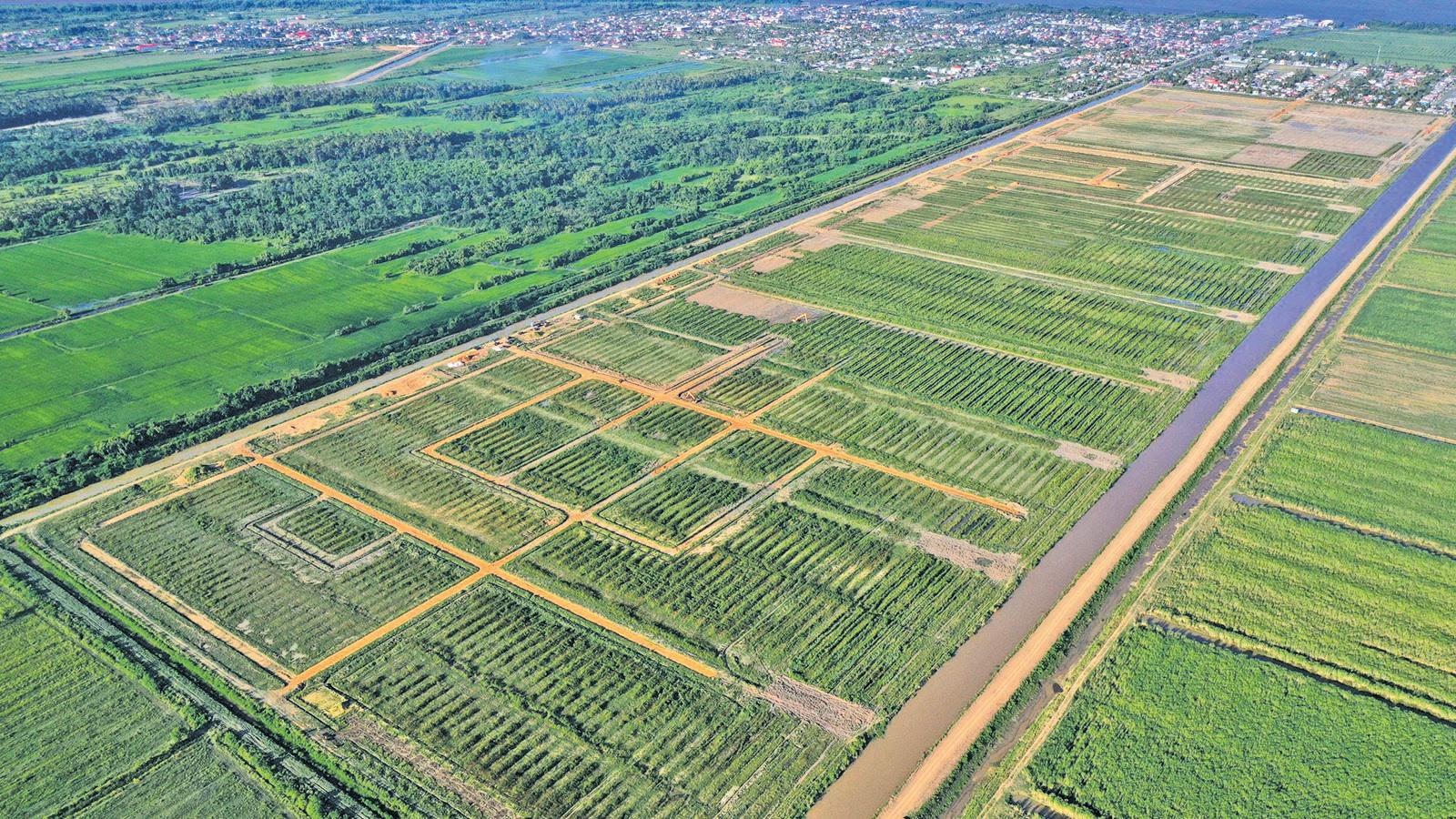
Over $2 billion is being invested into infrastructure for the Shieldstown Housing Development in Region Five (Mahaica-Berbice).
The project, which includes road construction and installation of drainage networks, is divided into six lots. Once completed, the scheme will yield over
Following land inspection, Croal urged contractors to take advantage of the current dry season to expedite the project and ensure that allottees gain swift access to their lands.
He further emphasised the substantial investments made in the region thus far, with over 1000 house lots already allocated
solve their specific issues.
Additionally, several allocations were done for persons with existing applications.

Last November, some 700 residents were allocated their low-income and moderate-income house lots— costing between $200,000 to $500,000 each—within
700 residential house lots.
On Friday, Housing and Water Minister Collin Croal conducted a site visit in the area alongside Member of Parliament Faizal Jaffarally, Regional Chairman Vickchand Ramphal, Central Housing and Planning Authority (CH&PA) Director of Community Development Gladwin Charles and senior engineers.
to residents.
Meanwhile, some $4 billion is being expended to collectively develop the Shieldstown, Blairmont (Balthyock), Experiment, and Burma Housing Schemes, with the Ministry seeking to acquire additional lands in the region.
To better address individual concerns, Croal also conducted one-on-one meetings with residents to re-
the Shieldstown Housing Scheme during the region’s second “Dream Realised” housing drive of 2022.
The first allocation exercise, which was held earlier last year, saw at least 400 persons being assigned their house lots.
These exercises form part of the Housing Ministry’s agenda of distributing 50,000 house lots by 2025.

SUNDAY, JULY 23, 2023 | GUYANATIMESGY.COM

Bacchus has said there are no limits to learning, but he noted there are challenges which he encounters from time to time. Among them, he said, is new students’ ability to adapt to the use of technology, especially
those attending online from their homes. “They may take additional time to send in their work,” he said.
He said smooth and efficient internet speed is another issue, and to curb the problem, the school installed Wi-Fi services
from two local service providers. “So, we have a GTT and we have one from E Networks. So, when one is down, we switch to the other,” he said.

Electricity is another issue: when there is a blackout, the students attending online are affected. He said the school is working to install a standby generator to address this issue.
If a teacher is unable to attend school on any given day, Bacchus said, the school has soft copies of the work, which are uploaded for the students to follow. When the teacher attends the next class, the lesson is then taught. “At least they have the content, so when the teacher comes to the next class, she can do her explanations,” he added.
He said the school is developing soft copy modules to make teaching easier for the staff. He said if the teacher is out of the class for an unforeseen reason, the lesson is available for another teacher to give to the students.
The future of the school Bacchus said officials of the Ministry of Education have visited the school on multiple occasions, and they were “wowed that we are still able to conduct classes using the online platform, and maintain that systema and make it efficient.”
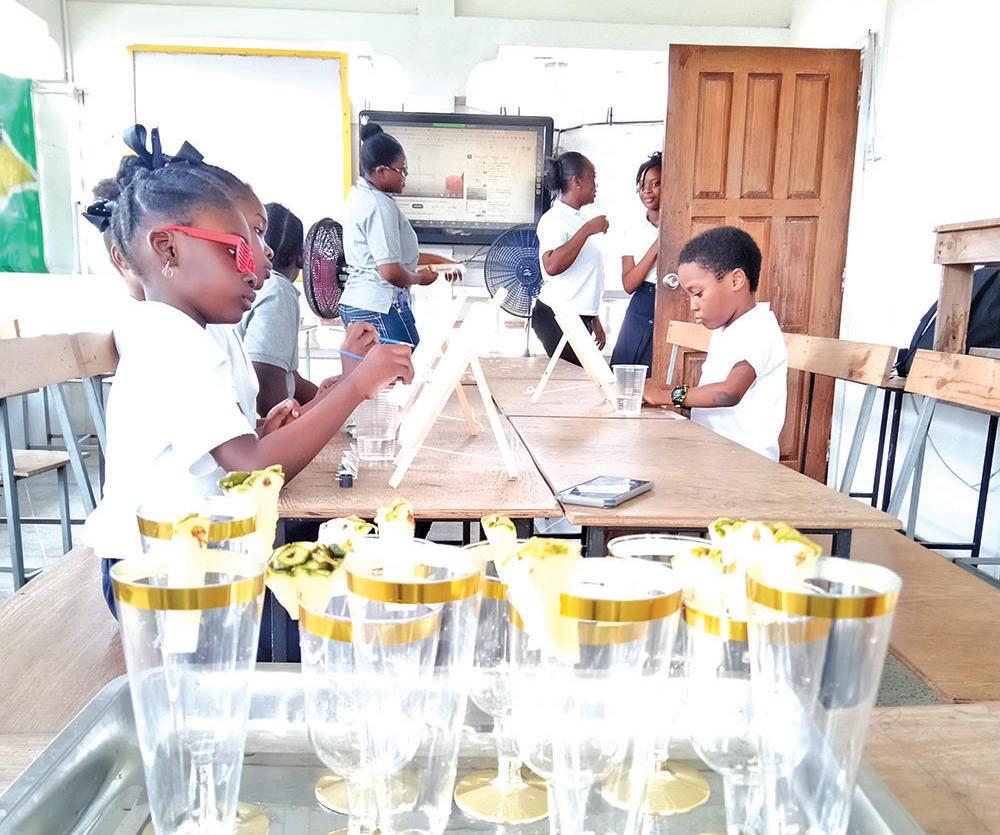
He said it costs around $500,000 to install the technology for one classroom, and this includes the TV screen,
which is the costliest device for the classroom.
He said that, in the future, the school would continue to be innovative, and he noted that he plans to invest in additional space. He said that within the next five years, he plans to secure a bigger facility for the school to operate from, and this would give the school additional options in terms of enhancing its curriculum.
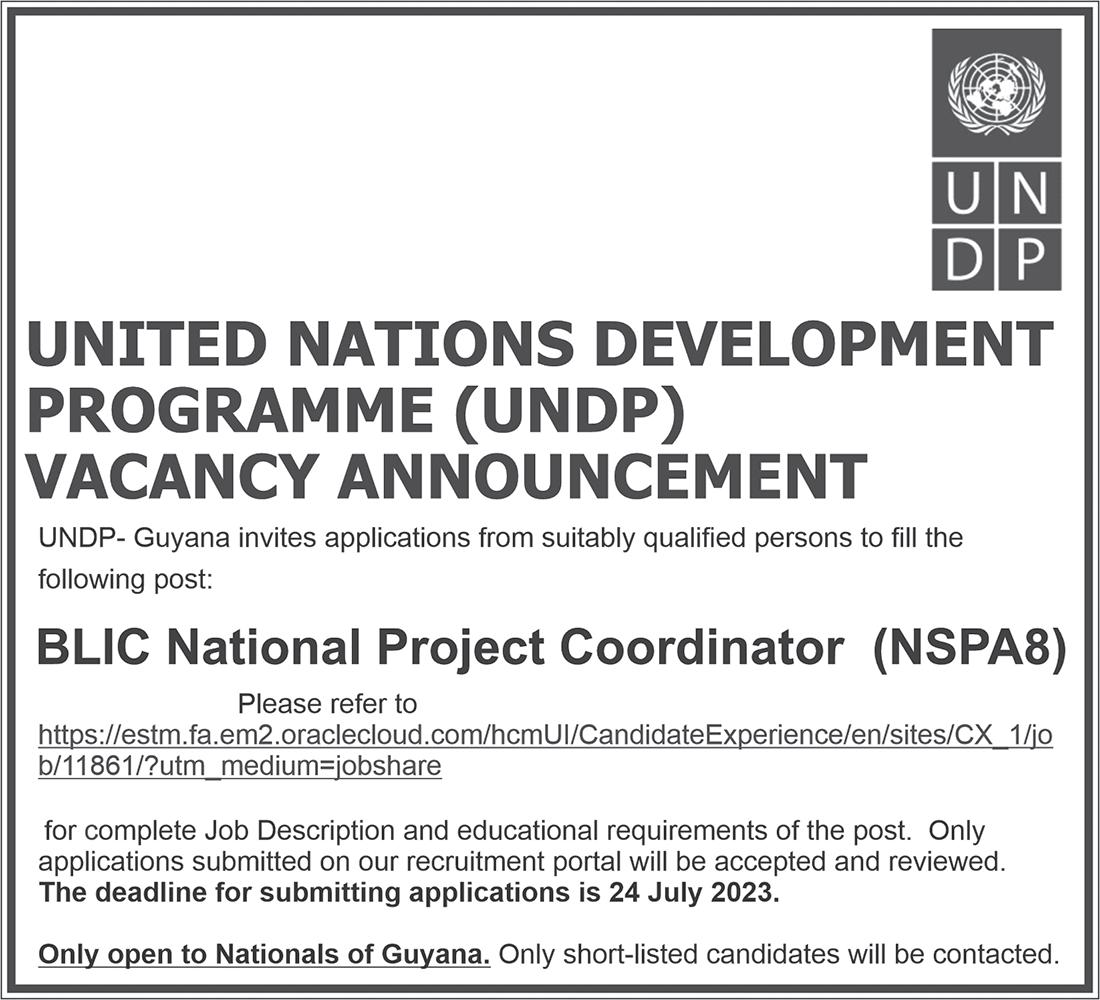
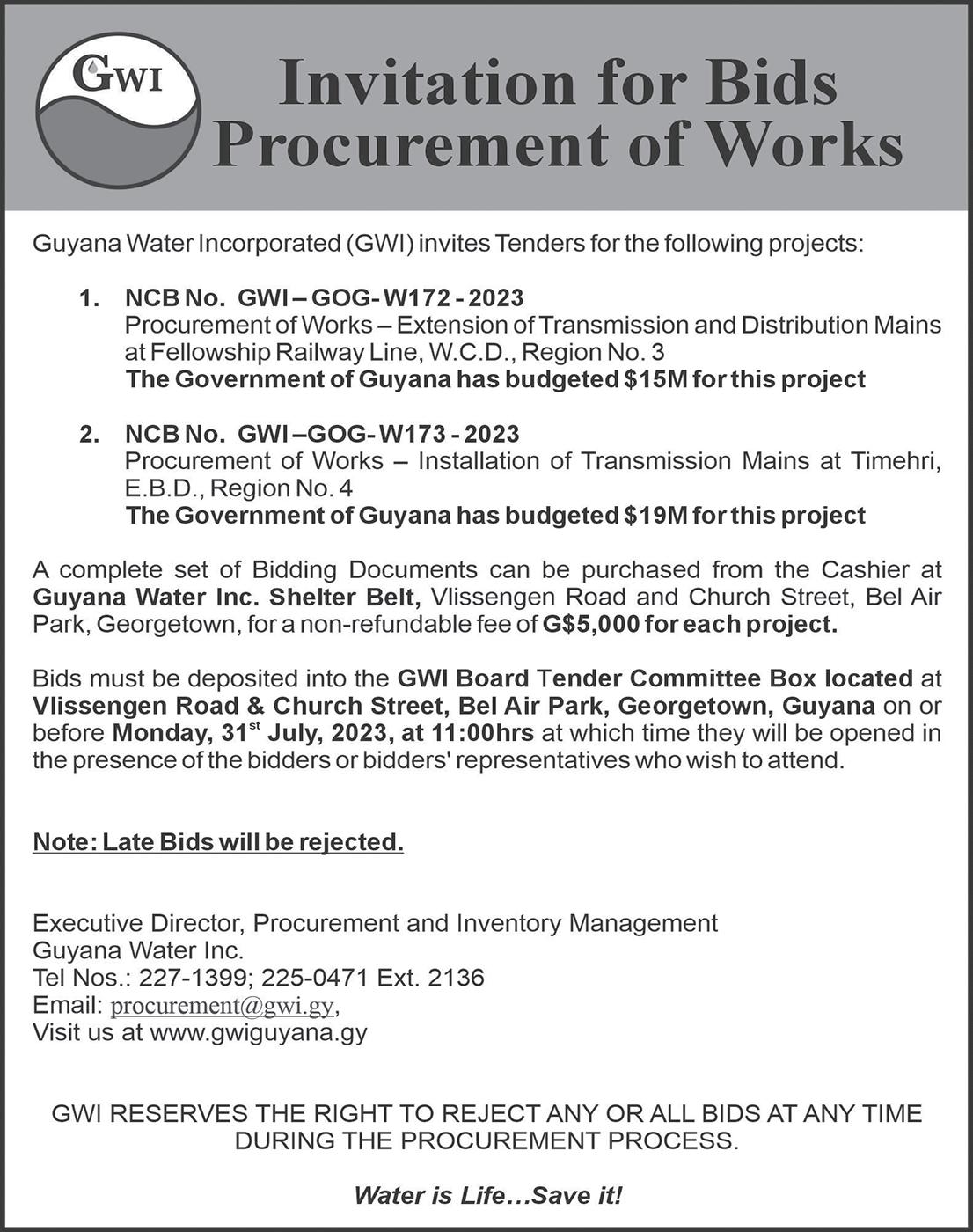
“Sometimes we may encounter a glitch while teaching using technology, but we have been using it for so long (that) we have mastered this technology, (such) that we can troubleshoot the system and still continue to teach our students and resolve the issue,” Bacchus said.
He said Bacchus Learning Centre does now view itself as a competitor with other private schools, since his goal is to ensure that students benefit from the teaching methods offered by the school to realise their true potential.
(December 7, 2028) until the final payment (December 1, 2043) are laid out in the amortisation schedule.
Each instalment amounts to $6.2 million Saudi Riyals (US$1.6 million) for the Wismar Bridge loan and $12.4
million Saudi Riyals (US$3.3 million) for the housing infrastructure loan.
Amonth after the Government would have signed a historic US$150 million in loans with Saudi Fund for Development (SFD), it turns out that favourable terms of two per cent and a payback period of 20 years were secured for Guyana. A perusal of the loan
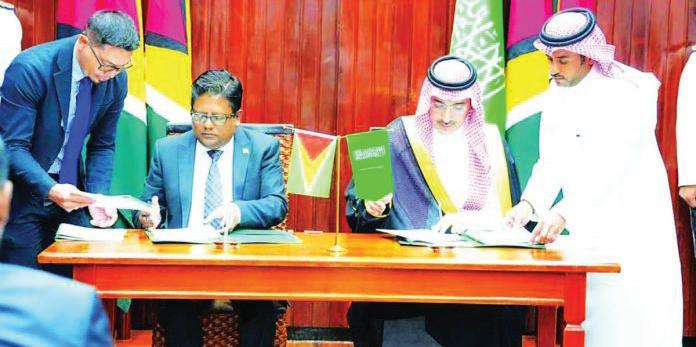
agreements, which were seen by this publication, shows that both loans - US$50 million for construction of the Wismar Bridge and US$100 million for infrastructural development in the housing sectoralso come with a two per cent interest rate on the principal amount of the loan.
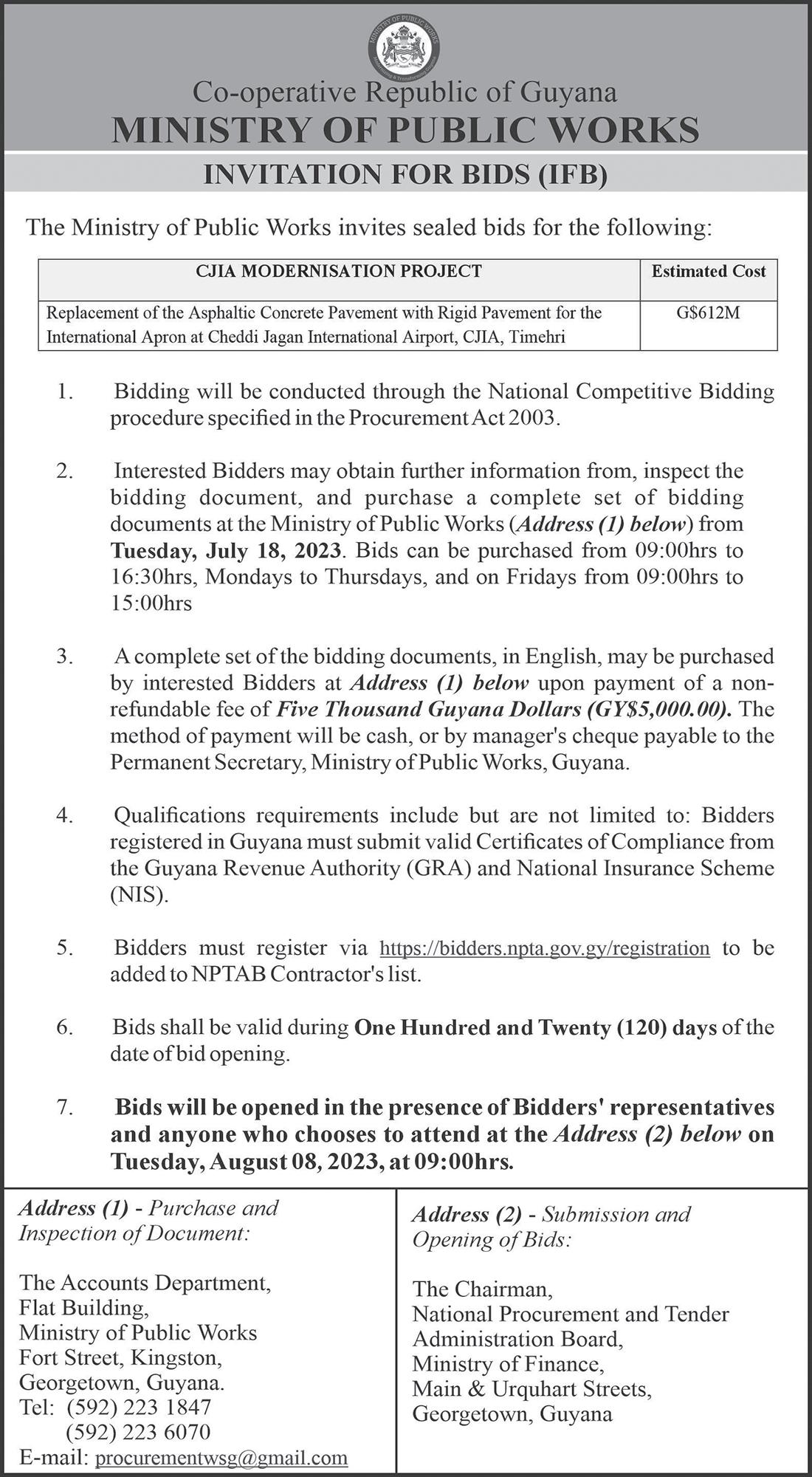

It was explained in the agreement that the loan charge and other charges will be payable semi-annually on January 30 to July 30 each year, over the duration of the 20-year maturity period. Meanwhile, a total of 30 payments from the scheduled date of the first instalment

As Guyana continues to experience unprecedented growth and job expansion, the Government is committed to working with the private sector to resolve skills gaps within the local labour market.

Senior Minister in the Office of the President with Responsibility for Finance, Dr Ashni Singh made this remark on Friday during a multi-stakeholder forum on Guyana’s labour needs.
This was hosted by the Foreign Affairs and International Cooperation Ministry’s Diaspora Unit at the Arthur Chung Conference Centre (ACCC).
“We, as a Government, are committed to working with the private sector and the labour force to resolve any mismatches that might exist in the labour market because our objectives are very simple. We want a competitive private sector, which means having people with relevant skills. And we want as many Guyanese people working in fulfilling and satisfying jobs,” Singh said. Singh noted the existing contrasting realities whereby the private sector often faces challenges in finding skilled workers while job seekers across the country
struggle to secure placements.
“How do you reconcile that on the employer side of the conversation, you're being told they can't get people and on the supply side, or potential worker population, are saying to you, they can't get jobs? How do you reconcile these two realities?” Singh pondered.
Recognising the need, therefore, to ensure persons have the requisite skills needed to fulfil their job requirements, Singh stated that efforts are being made to pro-

vide training and educational opportunities.
“We're working through innovative means including programmes such as the Guyana Online Academy of Learning (GOAL) programme. We are ramping up technical and vocational training, including through the traditional technical institutes, through the Board of Industrial Training (BIT), and very shortly through the Guyana Technical Training College, which is going to be home to the National Oil and Gas Institute and to the National Tourism and Hospitality Institute that is currently being built,” Singh explained.
In turn, Minister Singh expressed a need for Guyanese to rethink the way they view their work by removing themselves from the notion that certain jobs hold value over others and by being willing to be occupationally mobile.
“There is this concept that you have arrived if you work in an office…[We are] more and more encouraging people to practice occupational mobility, reskilling and retraining and going to where the jobs are,” Singh said.
“Part of this is communication–explaining to peo-
ple where the opportunities are, what these opportunities
pay and destigmatising some types of work,” Singh added.
Job expansion
From the Ogle to Eccles four-lane highway to the construction of the Maternal and Child Health Hospital, from to the potential bridge link between Guyana and Suriname to the construction of several hotels, stadiums, municipal airports and oil and gas-related projects, Public Works Minister Juan Edghill stated that there is a growing need for workers.
“Right now, [there’s over] 60 foreign nationals that are here driving [trucks for the construction of the Ogle to Eccles road]. And I could as-
sure you that through the Ministry of Public Works and through their own advertising, they have been hunting to get drivers locally for those trucks. So that's just an indication of how the demand for labour is becoming,” Edghill said.
While the Government was compelled to seek foreign expertise on many of these projects, Edghill maintained a need to continue upskilling Guyanese workers so the country can become more self-reliant.
“We want to see more Guyanese being employed, partaking in economic activities and benefiting from it as well,” Edghill said.
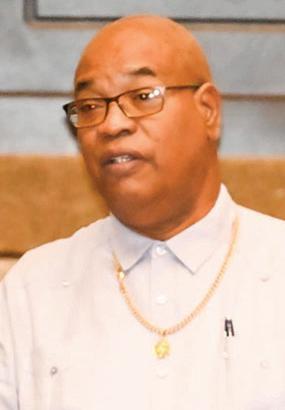
The Al Ghazali Islamic Academy held its primary school graduation and prize-giving ceremony on Saturday, with students graduating from the National Grade Six Assessment with 100 per cent pass rate. The pupils were awarded for their excellent work in the various subject areas, which included Islamic studies.
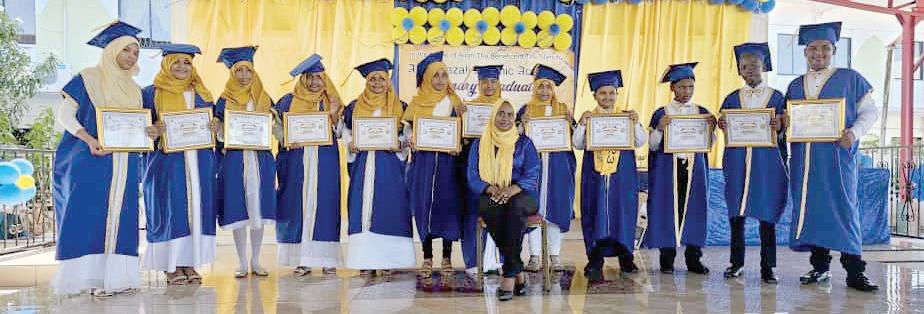
Director of Education and Dawah of CIOG-Shaykh Moeenul Hack in his charge
spoke about being disciplined, focused, remaining humble and remembering their parents and all those who helped them along the way.
The guest speaker, Deborah London, urged the students to be consistent in what they do and to learn something different each day.
In a release on Saturday, the school thanked class teacher, Roshanie Ramlochan for her commitment and dedication in teaching and guid-
ing the students.
“Our gratitude to all sponsors, lesson teachers, parents, guardians and well-wishers in playing their part of the children's success. We wish them all the very best as they proceed on to their journey in secondary schools.”
Among some of the schools that the graduating students will be attending are Queen’s College, Christ Church and Annandale Secondary Schools among others.
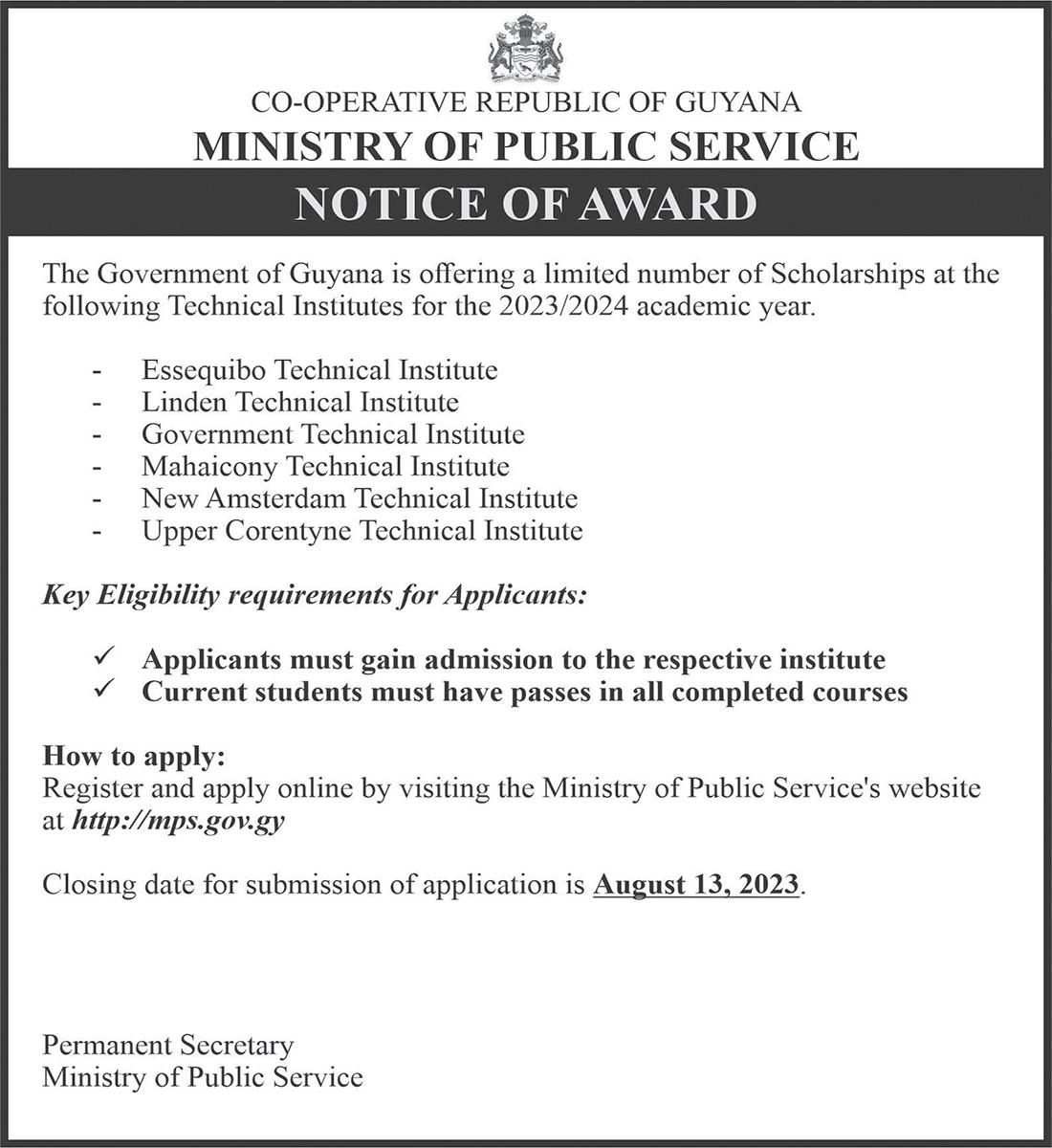

Traffic statistics released by the Guyana Police Force at the Force’s symposium on Friday for the period spanning January 1 to July 17 in 2022 and 2023 have revealed concerning trends in road safety.
Despite a 50 per cent reduction in child fatalities resulting from fatal accidents, the nation has experienced a substantial 26 per cent increase in overall traffic accidents and a 30 per cent rise in fatalities during 2023 when compared to the previous year.
Most strikingly, the majority of those involved in fatal accidents during the period under review were males. The data indicated a concerning 38 per cent increase in male involvement in accidents (18), while the number of females remained constant in 2023.
Further, the age range of 25 to 42 years saw the highest involvement in traffic accidents in both
years. In 2023, there was a staggering 67 per cent increase (12) in persons aged 25-42 involved in accidents, followed by a 31 per cent increase (5) in the 17-24 age group. Additionally, there was a 16 per cent increase (5) in drivers aged 25 to 42 involved in fatal accidents compared to 2022.
The report also highlighted the grim fate of motorcyclists and pillion riders on the roads. In 2023, 108 per cent more motorcyclists lost their lives in accidents, accounting for 14 fatalities.
The number of pillion riders who tragically died in accidents surged by an
alarming 700% in 2023. Additionally, four minibus passengers lost their lives in accidents during 2023, compared to the previous year.
A thorough review conducted by the Guyana Police Force pinpointed speeding as the leading cause of these accidents. Alarming data revealed an 87% increase in speeding incidents in 2023 compared to the previous year. Driving under the influence was also found to be a contributing factor, though the number of accidents related to this cause decreased from four in 2022 to one in 2023.
On a positive note, pe -
destrian fatalities saw a 50% decline in 2023 compared to the same period in 2022, signifying a potential positive shift in road safety awareness and practices.
Despite the efforts to improve child safety on the roads, with a commendable 50% decrease in child fatalities in 2023 compared to 2022, the overall traffic statistics are a cause for concern.
As such, the Guyana Police Force in collaboration with other relevant authorities said they will intensify their efforts to address the surge in traffic accidents and fatalities.
They mentioned various safety campaigns and initiatives that could be considered, focusing on the promotion of responsible driving behaviours, adherence to speed limits, and the dangers of driving under the influence. Moreover, they are currently conducting comprehensive road safety edu -
cation for all age groups which will play a crucial role in reducing the number of accidents.
As Guyana grapples with the alarming rise in traffic accidents and fatalities, there is an urgent need for collective action from citizens, authorities, and stakeholders to create safer roads for everyone. By addressing the root causes and implementing effective measures, the nation can pave the way for a future with reduced road accidents and tragedies.
In this light, the Home Affairs Ministry has been collaborating with stakeholders to develop a comprehensive action plan to reduce road accidents and fatalities by 50 per cent by 2030.
The National Assembly passed the Motor Vehicle and Road Traffic (Amendment) Bill in 2022, which aims to promote and enforce safe driving and impose higher penalties for serious infractions.
The National Road
Safety Council’s financial resources have been boosted to over $11 million, aiding in sensitisation and reducing road accidents. The Ministry of Home Affairs is committed to providing evidence-based road safety knowledge and awareness programmes through advocacy, training, and education, to create a culture of safety among all road users, including young adults.
The Government is also upgrading roads and highways and installing lights and CCTV cameras at strategic points to improve infrastructure and safety.
Augmenting these efforts, the Traffic Department is intensifying efforts to prevent speeding and urges drivers to exercise caution on the roads, follow traffic laws and regulations, and maintain their vehicles regularly. Safe driving practices such as wearing seatbelts and avoiding distracted driving are emphasised.
There is also a five-year grace period for both loans.
Back in June 2023 and in a move that further cements the growing relationship between Guyana and the Middle East, the Dr Irfaan Ali-led Administration had signed the historic US$150 million loan with the SFD to finance the transformational infrastructural projects.
The signing of these agreements was part of the efforts undertaken by the Kingdom of Saudi Arabia, through the SFD, to support sustainable development in developing countries and Small Island Developing States (SIDS). Since its establishment in 1974, SFD has implemented more than 700 development projects and programmes in 87 countries around the world. However, the signings mark SFD’s first foray into Guyana to finance major development projects.
The signing had taken place at the Office of the President, with President Ali and a number of Cabinet Ministers in attendance. Finance Minister Dr Ashni Singh signed on behalf of the Government while Chief Executive Officer (CEO) Sultan Abdulrahman AlMarshad signed on behalf of the SFD.
In his remarks, AlMarshad had revealed that Guyana is the 88th country to receive money from the Fund for major proj -
ects. He had also described both the scope and the direct and indirect benefits of the loan, which will go towards the construction of over 2000 houses and the long-awaited four-lane Wismar-McKenzie Bridge in Region 10 (Upper Demerara-Berbice) that will be built parallel to the existing one.
President Ali had meanwhile lauded the Saudis for the speed with which they advanced funds for the infrastructural projects. President Ali also observed that not only was the financing provided by the Saudis, but the cost of financing is “second to none”.
“We are on a trajectory in which we are seeking also to build new relationships. To enhance and strengthen old relationships and to build new ones. We have been actively working in your geographic space. And we’re seeing tremendous results. We’re seeing that the activism is leading to meaningful outcomes. And we look forward to this continued partnership and the speed with which you operate, in helping us on this journey of modernisation,” President Ali had said.

Urging Saudi Arabia to also avail itself of private sector investment opportunities in Guyana, The President was hopeful that they could have further discussions on priority areas for funding on the next phase of development.
FROM PAGE 23
The President had further noted that the projects will not only bring temporary relief but also permanent benefit to citizens as it forms part of the larger infrastructure masterplan of the country and will help Guyana on its journey to modernisation.
In addition to the 2500 housing units that will be built across three different regions in Guyana, the project includes paving the main and secondary roads, establishing water, sewage and electricity networks, digging wells for each of the project areas, and the construction of social facilities serving multiple benefits. It will not only address the current housing shortage and improve living conditions but also stimulate the local economy through direct and indirect job opportunities in the housing sectors.
Meanwhile, the new Wismar/McKenzie Bridge the Government intends to build is a four-lane one that will be able to facilitate the increased volume of traffic through Region 10. The current Wismar Bridge only has a one-vehicle lane and is over 50 years old. Back in 2020, Italian engineering company Politecnica unveiled designs for a new bridge. The company had been contracted by the then Ministry of Public Infrastructure to do a feasibility study for the bridge. (G3)
AVreed-en-Hoop, West Bank Demerara (WBD) resident has won a lawsuit against the owners of a popular business, whose building is trespassing onto the neighbouring property.
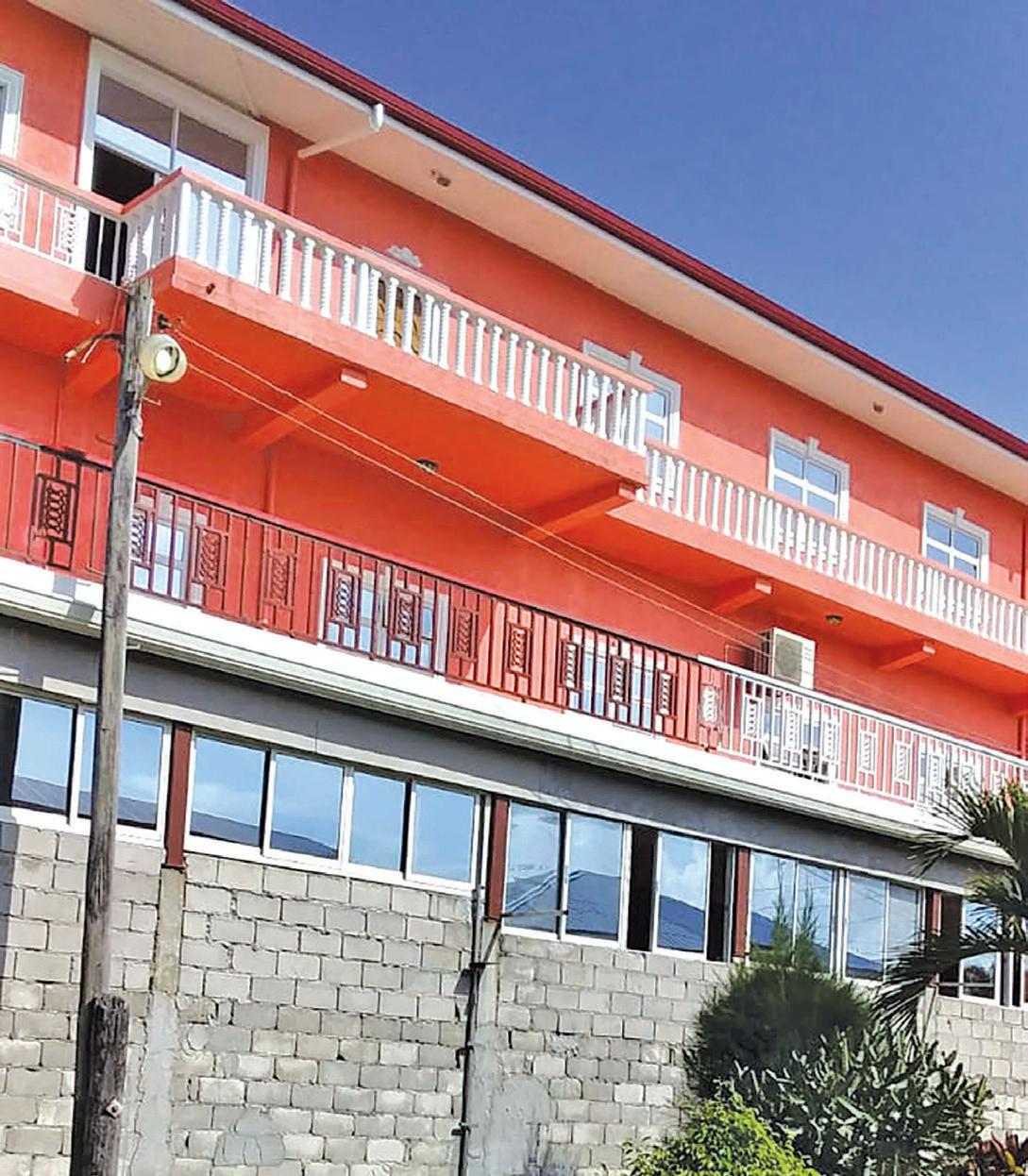
This was the ruling of High Court judge, Justice Priya Sewnarine-Beharry, who delivered the written decision on Friday.
The case was filed by Vreed-en-Hoop resident, Dian Balram – the claimant, against Samuel Chandool and Chitralekha Chandool – owners of the three-storey building that houses Amanda’s Bridal.
In her ruling, the High Court judge found that the defendants’ building is trespassing onto Balram’s property and ordered that they demolish those parts of the building, which should be four feet away from the boundary line. She also ordered the defendants to pay Balram some $1.75 million in damages and costs.
According to the court documents, the three-storey building in question was constructed in 2015. However, in 2019, the defendants extended the building westward onto the concrete fence, which borders Balram’s property.
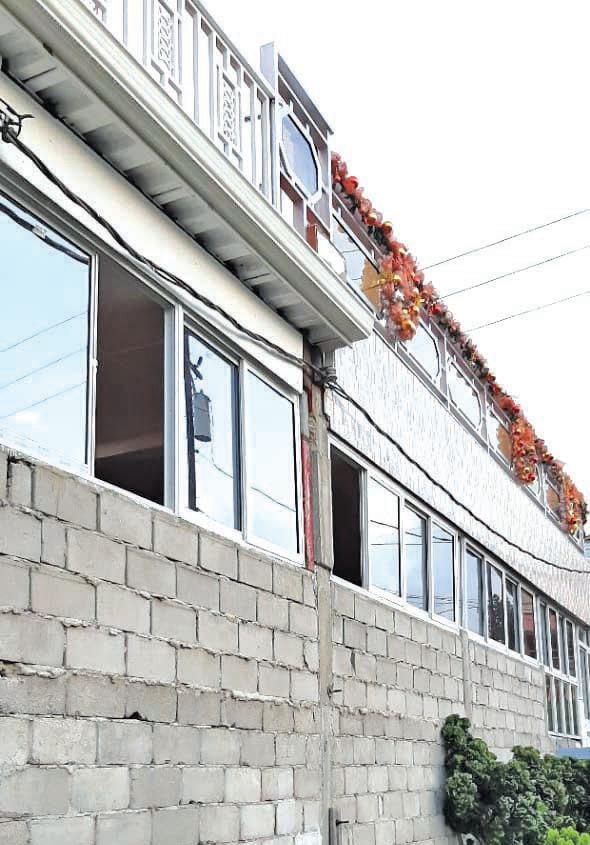
In the process of that construction, the defendants broke the fence at intervals, placed steel upright at these intervals and extended their building so that its western wall is in line with and incorporates the fence and uprights. They also built a large, concrete platform without any drainage extending from their building which rests on the fence and overhung onto the claimant’s property.
The court document further states that no building permission was given to the defendants under the provisions of the Public Health Ordinance or otherwise to undertake the construction, which encroaches within four feet of the boundary in breach of the provisions of the Ordinance and its Regulations.
Additionally, the weight of the construction caused the sinking of Balram’s eastern gatepost, which is now seven inches lower than the western gatepost. The land is also now more prone to flooding since the construction as there is no drainage on the western side of the building for water to run off.
It was noted too that there were pipes emanating from the defendants’ property where rainwater was directed from their building and property onto Balram’s property, and other pipes where smoke was directed onto her property as well.
During the trial, the court was tasked with determining whether the defendants trespassed upon Balram’s land, and whether her cause of action lies in public or private nuisance, or both.
Trespassed
In the determination of the first issue, Justice Sewnarine-Beharry found that the location of defendants’ building on the fence necessitated trespass by the personnel and equipment of the electricity utility onto Balram’s property and the running of electric wires over her land. The court also found that during their construction, the defendants trespassed upon Balram’s land and broke her gate and deposited debris on her property as well as destroyed the plants growing along the border.
“This court finds that the claimant has proved that the defendants trespassed upon her property on a balance of probabilities,” the High Court Judge ruled.
Nuisance
On the issue of whether Balram’s case is a public or private nuisance, the Judge cited legal definitions of the two matters.
It was explained that a nuisance which interferes with a person’s use or enjoyment of land or of some right connected with land, but which does not cause damage or inconvenience to the public, it is a private nuisance and as such an actionable tort (37 Halsbury’s
action in tort for that nuisance. (37 Halsbury’s Laws 3rd ed 122).
Citing Clerk & Lindsell, Justice Sewnarine-Beharry surmised that “…it appears that if the claimant suffers in a way greater than the general public, that may give rise to a cause of action in tort for both public and private nuisance.”
She further pointed to Lord Cooke in Hunter v. Canary [1997] A.C. 665 at pg. 721, which states: “I see no reason why neighbours prejudicially affected should not be able to sue in nuisance if a building does exceed height, bulk or location restrictions. For then the developer is not making either a lawful or a reasonable use of landowning rights. This is to treat planning measures not as creating rights of action for breach of statutory duty but as denoting a standard of what is acceptable in the community.”
feet of the boundary.
Laws (3rd ed 121)
It was also noted that a nuisance which inflicts damage, injury or inconvenience on the public or a class of the public which comes within its sphere of operation, constitutes an indictable misdemeanour known as common or public nuisance. However, if a private individual can show that he/she has suffered some particular direct and substantial damage to person or property over and above that sustained by the community at large, he/she has a right of
To this end, the High Court Judge said “The defendant’s actions and omissions in causing water runoff and debris unto the claimant’s property, subsidence of the gatepost and encroachment unto her property by the construction of a concrete platform which overhangs the claimant’s property by two feet has substantially interfered with her use and enjoyment of the land.”
Further, the court also found that it is undisputed that the defendants criminally breached the Public Health Ordinance Chapter 145, its By-Laws, Building Regulations by failing to obtain building permission and undertaking construction which encroached four
“It is noteworthy that though injury to the claimant is occasioned by a contravention of these provisions, her cause of action is not rooted in a violation of the Ordinance and its Regulations but in the tort of public nuisance as she suffered particular damage over and above the general inconvenience suffered by the public, evident by the dimensions of the building, its connection to the fence and boundary and the overhang over her property… In this regard the acts of the defendants are an actionable public nuisance,” the Judge ruled.
In the circumstances, Justice Sewnarine-Beharry declared in her written decision, that the defendants are bound by the Public Health
Ordinance and its Building Regulations, which prohibits the construction of any building within four feet of a boundary of their property. She also ordered “a mandatory injunction directed to the defendants and each of their servants and/or agents to demolish and remove all and any part of the building… which may lie within four feet of its western boundary… [adjacent to the property] owned by the claimant…”
The High Court Judge also granted Orders for the defendants pay Balram damages in the sum of $750,000 for trespass and another $750,000 in damages for nuisance. The claimant was also awarded costs in the sum of $250,000 to be paid by the defendants on or before August 31, 2023.

The ceremonial mayoral chain in New Amsterdam has been missing for several years, but this is only now coming to light after the newly-elected Mayor was sworn-in.
Town Clerk Sharron Alexander admitted that the chain was missing when the new Mayor was elected on July 7, last and a never-before-seen chain was being put around his neck during the swearing-in ceremony Former Mayor Winifred Haywood was the last Mayor seen wearing the chain, in 2018, which serves as an insignia to show that the wearer is the Mayor and head of the town.

The mayoral chain is referred to as the Livery Collar or Civic Regalia.
In 2018, the chain worn
by Mayor Haywood seemed significantly shorter that the chain worn by previous Mayors.
Back in 2020, media representatives had questioned the absence of the chain when the then Mayor Winifred Haywood was ad-
dressing the Council.
However, when asked about the missing chain, Mayor McIntosh, who was the Deputy Mayor in 2020, said he needed to find out from staff at the municipality before he could make a statement. Asked if he would be calling in the Police, McIntosh main-
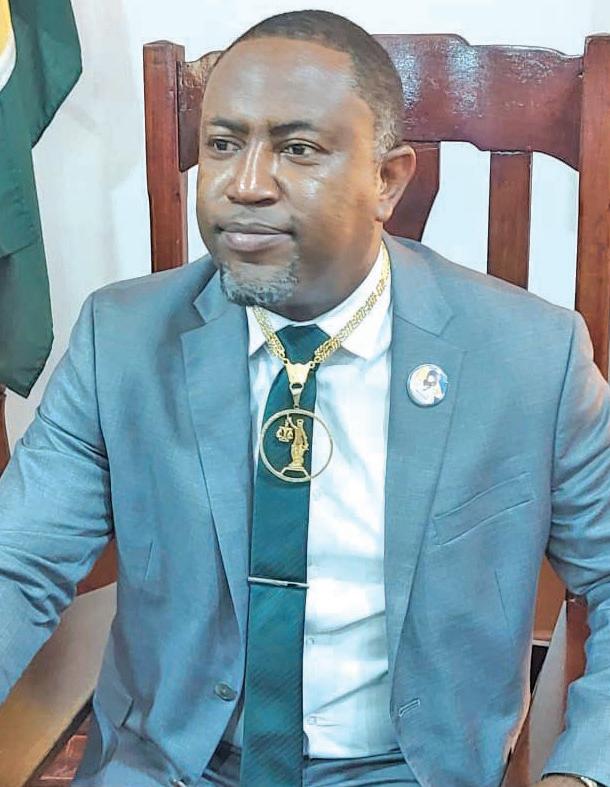
tained that he would first have to be updated by staff.
During a press conference on Friday, McIntosh was again asked for an update on the missing ceremonial chain.
“I would like to refer you to the security arm of the New Amsterdam Municipality,” was the Mayor’s response.
Sargent Paula Solomon of the Town Constabulary said her superior is currently on vacation and that officer was in contact with the Police investigating officer.
Nevertheless, she said an investigation conducted by the Police was done in 2020, but she could not provide further details.
The chain was being kept in the vault, and according to Sargent Solomon, multiple persons had access to the vault. (G4)


The Group of 20 (G20) major economies meeting in India failed on Saturday to reach consensus on phasing down fossil fuels following objections by some producer nations.
Scientists and campaigners are exasperated by international bodies’ foot-dragging on action to curb global warming even as extreme weather from China to the United States underlines the climate crisis facing the world.
The G20 member countries together account for over three-quarters of global emissions and gross domestic product, and a cumulative effort by the group to decarbonise is crucial in the global fight against climate change.
However, disagreements including the intended tripling of renewable energy capacities by 2030 resulted in officials issuing an outcome statement and a chair summary instead of a joint communique at the end of their four-day meeting in Bambolim, in the Indian coastal state of Goa.
A joint communique is issued when there is complete agreement between member nations on all issues.
“We had a complete agreement on 22 out of 29 paragraphs, and seven paragraphs constitute the Chair summary,” Indian Power Minister RK Singh said.
Sections urging developed countries to deliver on the goal of jointly mobilising US$100 billion per year for climate action in developing economies from 2020-2025, and description of the war in Ukraine, also eluded consensus.
Fossil fuel use became a lightning rod in day-long discussions, but officials failed to reach consensus over curbing “unabated” use and argued over the language to describe the pathway to cut emissions, two sources familiar with the matter said.
A draft late on Friday reviewed by Reuters read: “The importance of making efforts towards phase down of unabated fossil fuels, in line with different national circumstances, was emphasised.”
However, the chair statement released on Saturday evening included concerns from some member nations which were missing in the Friday draft, noting that “others had different views on the matter that abatement and removal technologies will address such concerns”.

Singh, in a press briefing after the conference, said some countries wanted to use carbon capture instead of a phase down of fossil fuels. He did not name the countries.
Major fossil fuel producers Saudi Arabia, Russia, China, South Africa and Indonesia are all known to oppose the goal of tripling renewable energy capacity this decade. (Reuters)
Adrone attack on an ammunition depot in Crimea prompted authorities to evacuate a 5 km (3 mile) radius and briefly suspend road traffic on the bridge linking the peninsula to Russia, the region’s Moscow-installed governor said on Saturday.

Ukraine said its army had destroyed an oil depot and Russian army warehouses in what it called the “temporarily occupied” district of Oktiabrske in central Crimea.
The attack caused an ammunition depot to explode, said Russian-installed governor Sergei Aksyonov, adding there was no reported damage or casualties.
Russia seized and annexed Crimea from Ukraine in 2014, eight years before launching its full-scale in-
vasion of the country.
The brief halting of traffic on the Crimean Bridge, about 180 km (110 miles) to the east of the drone incident, came five days after explosions there killed two people and damaged a section of roadway - the second major attack on the bridge since the start of the war.
The 19 km (12 mile) road and rail bridge is a vital logistics link for Russian forces, and is also heavily used by Russian tourists who flock to Crimea in summer.
Ukrainian President Volodymyr Zelenskiy said on Friday that the bridge was a legitimate target because it was a military supply route for Russia.
“This is the route used to feed the war with ammuni-
tion and this is being done on a daily basis,” he said. Russia is on high alert for incidents at the bridge, and an official Telegram channel tells people not to panic in the event of an alarm.
In a further sign of security concerns in Crimea, Oleg Kryuchkov, an adviser to Aksyonov, warned people not to post images of critical infrastructure on the internet. (Excerpt from Reuters)
Aseries of climate records on temperature, ocean heat, and Antarctic sea ice have alarmed some scientists who say their speed and timing is unprecedented.
Dangerous heatwaves in Europe could break further records, the UN says.

It is hard to immediately link these events to climate change because weather - and oceans - are so complex.
Studies are under way, but scientists already fear some worst-case scenarios are unfolding.
“I’m not aware of a similar period when all parts of the climate system were in record-breaking or abnormal territory,” Thomas Smith, an environmental geographer at London School of Economics, says.
“The Earth is in uncharted territory” now due
Brazilian President Luiz Inacio Lula da Silva on Friday signed an executive order tightening civilian access to firearms in a bid to slow a surge in gun ownership during the presidency of his far-right predecessor Jair Bolsonaro.
The decree fulfils a campaign promise by Lula, who criticised looser gun controls under Bolsonaro, arguing they were responsible for a wave of political violence during last year's election.
Bolsonaro, who often urged his supporters to arm themselves or risk being "enslaved," has said guns make Brazil safer,
pointing to a lower murder rate during his time in office.
The country has nearly 800,000 registered gun owners, up from 117,467 in 2018 when Bolsonaro was elected, according to the 2023 Brazilian Yearbook of Public Security.
Bolsonaro turbocharged gun culture by loosening restrictions on "hunters, marksmen or collectors," (CACs) making it easy for people to register for such permits and stockpile weapons.
Lula's decree rolled back firearms access for that group.
A registered hunter now can own six weapons, in-
stead of the previous 30 including up to 15 restricted firearms. Hunters will also have access to fewer bullets and need clearance from environmental protection agency Ibama.
"It is one thing for a citizen to have a gun at home for protection and assurance ... but we cannot allow there to be arsenals of weapons in people's hands," Lula said in a speech at an event to present the measures.
"We will continue to fight for a disarmed country. Who has to be well-armed is the Brazilian Police. It is the Brazilian Armed Forces," the President added. (Excerpt from Reuters)
to global warming from burning fossil fuels, as well as heat from the first El Niño - a warming natural weather system - since 2018, says Imperial College London climate science lecturer Dr Paulo Ceppi.
Here are four climate records broken so far this summer - the hottest day on record, the hottest June on record globally, extreme
marine heatwaves, record-low Antarctic sea-iceand what they tell us.
The world experienced its hottest day ever recorded in July, breaking the global average temperature record set in 2016.
Average global temperature topped 17C for the first time, reaching 17.08C on July 6, according to EU climate monitoring service
Copernicus.
Ongoing emissions from burning fossil fuels like oil, coal, and gas are behind the planet’s warming trend. This is exactly what was forecast to happen in a world warmed by more greenhouse gases, says climate scientist Dr Friederike Otto, from Imperial College London. (Excerpt from BBC News)
Cuba's economic growth is less than 2% this year and remains 8 percentage points below pre-pandemic levels, while production in sectors such as agriculture, mining and manufacturing was further behind, Economy Minister Alejandro Gil said on Saturday.
Speaking before the country's parliament, Gil said the primary sector, which includes agriculture, mining and other basic production, was down 34.9% compared with 2019, while manufacturing was off 20%. A third sector that includes services such as tourism, communications and education was down 4.9%.
Cuba, heavily dependent on food, fuel and other imports, largely blames US sanctions and the coronavirus pandemic for more than a 50% decline in its export earnings, which are needed to purchase imports, while admitting that market-oriented reforms have moved too slowly in the Communist-run country.
Gil said export earnings so far this year were US$1.3
billion, 35.7% of what had been expected, while imports were $4.4 billion, also well below the Cuban Government's forecast.
The Minister said inflation was raging at a 45% clip this year, on top of last year's 39% jump, a figure many economists say underestimates the rate as it does not adequately account for a growing informal market driven by scarcity.
Cuba has resorted to increased price controls to slow inflation, with little success to date, while conceding
other factors are driving up prices, such as low productivity and output.
"If there is no supply and production, we will not achieve effective price control," Esteban Lazo Hernandez, the President of Cuba's Parliament, said during a session earlier this week.
Gil said the crisis, which has left residents reeling, protesting and leaving the island nation, was "complicated," but he added that the government was working on solutions. (Excerpt from Reuters)
ARIES

(March 21April 19)
TAURUS (April 20May 20)
GEMINI (MAY 21June 20)


CANCER
(June 21July 22)



LEO (July 23Aug. 22)




Plan to have fun, but don’t let temptation and poor behavior take the reins. Social events, romance and personal gain are favored. Carry yourself with confidence and dash.


Keep a low profile and put your energy where it counts. Let your achievements, not your opinions, be your calling card. A challenge or competition will require discipline.
Choose your words wisely and avoid controversy. Someone will be looking for a fight or to beat you at your own game. Be thoughtful and kind, regardless of what others do or say.
Choose to take the road less traveled. Seek unique ways to use your skills and talents to get ahead. Surround yourself with interesting people who make you think.
You know the rules; now play to win. Don’t let anything or anyone stand in your way. Size up who is capable of what and surround yourself with experts. Settle for nothing less than what you want.
VIRGO (Aug. 23Sept. 22)



LIBRA (Sept. 23Oct. 23)


SCORPIO (Oct. 24Nov. 22)






Speed up and be spontaneous; the universe will accommodate you. Let the changes that occur dictate your direction, and masterfully use your intuition to take the best path.
Share your emotions, intentions and solutions, and you’ll get favorable feedback and the help you require to complete your mission. Reach out to those skilled in areas you lack.
Refuse to let the changes others make unnerve you. Think and do what’s best for you, and don’t fear being different. Put your energy into working with change and creating opportunities.
SAGITTARIUS (Nov. 23Dec. 21)





CAPRICORN





(Dec. 22Jan. 19)
AQUARIUS
(Jan. 20Feb. 19)
PISCES

(Feb. 20Mar. 20)





Arguing will waste your time. Walk away from discord, and handle frustrations physically by challenging yourself. Personal gain is your best revenge.
Take a moment to breathe and absorb what’s happening. Put your emotions on the back burner and study your alternatives. Lifestyle changes will work in your favor.
Keep a low profile. You’ll accomplish more if you are out of sight and working alone. Time spent in nature will allow you to think and adjust your plans to better suit your needs.
A change of plans will offer insight into something unexpected. Don’t be afraid to change direction midstream if it will help you make gains. Trust your instincts, but when in doubt, ask an expert.
Mitchell Marsh making relatively comfortable progress.
Labuschagne, who made his first half-century of the series on the opening day, was the more aggressive, taking advantage of anything loose as England’s quicks searched for any modicum of assistance with the old ball that, by and large, refused to do muchperhaps hindered by becoming damp over the outfield. Marsh, while playing second fiddle in what became a stand of 103 in 31 overs, did produce one cracking cover drive off Stuart Broad.

bring Wood back into the attack.

He summoned his spinners, and there were soon signs that they could be a threat, as one delivery from Moeen popped into Marsh’s gloves, but landed safely. Labuschagne took the positive route, dancing down to Root and twice sending him into the stands as he motored through the 90s. But, on 93, he had a scare when Root sent down one of his alternative seam-up swinging deliveries, which took the outside edge and flew too high and fast for Zak Crawley at slip.
delivery from Root bounced as Labuschagne attempted to cut, and the top edge was well held, after a rebound, by Jonny Bairstow.
It was not given on-field by Menon, although England reviewed in an instant and Labuschagne immediately indicated he knew he was out, tossing the bat frustratedly in the air.
Agloomy Manchester allowed more cricket than many thought would be possible on the fourth day, but England managed only one wicket in 30 overs in their push to send the series to a decider, as Marnus Labuschagne made his first away Ashes century before falling to Joe Root.

Root was bowling only because the umpires had told Ben Stokes that it was too dark for pace, a decision which did not appear to impress the England captain. However, after initially proving costly, as Labuschagne moved towards three figures with a brace of sixes, both Root and Moeen Ali caused problems late in the session with turn and bounce, and
the former broke through shortly before tea.
That was as far as play got, as steady drizzle returned and play was called off shortly before 6.30pm. The forecast for Sunday is bleak, with warnings for heavy rain in place for the northwest of the country, including Manchester, but England will hold onto the belief that they could still force victory with a small window of opportunity.
The second new ball is nine overs way - although now the umpires have taken a light reading that could become a factor - and Australia are still 61 behind. Were they to get into the lead, that would be another element to take out
time. A draw would see them retain the Ashes, taking a 2-1 lead to The Oval where the best England could achieve would be a shared series. Labuschagne’s century at least earned Australia the right to take it to the fifth day.
The rain had lashed down during the morning, but the biblical forecast improved as the hours wore on, and a gap emerged long enough for the clean-up operation to begin and play to start at 2.45pm. However, England struggled to replicate the intensity of the previous evening when Mark Wood had made sizeable inroads, with Labuschagne and
England were able to get the ball changed in the 58th over, but James Anderson was able to bowl only four deliveries with it before the umpires, Nitin Menon and Joel Wilson, ruled it was getting too dark just as Stokes prepared to
Next over, Labuschagne nudged Moeen into the off side and scampered the single that took him to his 11th Test hundred, his first in 24 innings and just his second overseas. He didn’t advance much further, though, as another slingy

double-digit figures in the face of destructive bowling from Demerara’s Brandon Henry, who returned figures of 4-12 even as Makai Dowlin grabbed 3-22.
Essequibo then turned on the pressure as they embarked on defending a low



Four balls later, Root nearly had Marsh as well, when he pushed with hard hands and got an inside edge that flew low to Harry Brook’s left at short leg. Brook could not quite channel Abdullah Shafique and hold on.
England were excited again with the last ball of the session, when an uncertain Cameron Green, who looks short on confidence with the bat, lunged forward and the ball ballooned to slip. England reviewed again, but this time there was no inside edge involved before it took the pad. That was the last action of the day. Once again, the two teams were left to nervously watch the weather forecasts.
(ESPN Cricinfo)Abrilliant all-round match performance from Bhomesh Lall has enabled Essequibo to capture the GCB U13 Inter-County title by handing Demerara a 15-run defeat yesterday at Bourda.

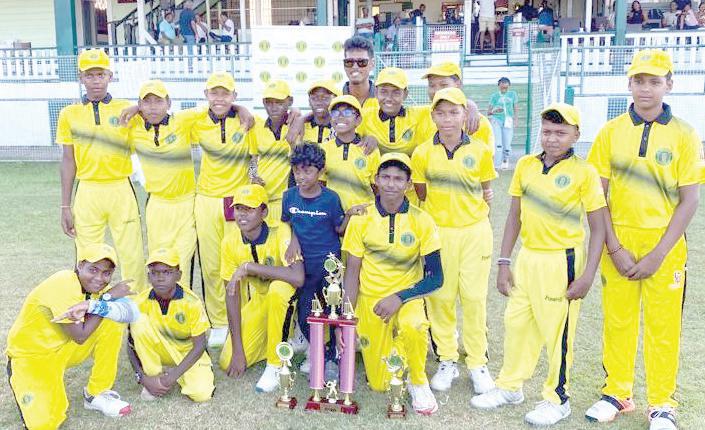
The Essequibo team en-



dured a few hiccups as they lost wickets at regular intervals, but they were never out of the contest, and they clawed their way back to victory.
Their batting revolved around top-scorer Lall, whose 41 at the top of the order enabled them to post 118 all out
in 37.4 overs, after losing a few key batters.
Mark Daniels (10) and Usain Fredericks (11) were the oth er two players to reach

score, and they pulled it off with relative ease, as they restricted Demerara to 103-9 by the time 40 overs had expired.
Demerara's only hope amid their 4 run-outs was Reyad Latiff (22), one of the unfortunate victims of poor communication between the wickets, and a spirited knock of 10 not out from Dowlin was all Demerara could offer, nobody else being able to reach double figures.
Bowling for Essequibo, Lall captured 3 wickets for 19 runs while Etan Silas and Makayan Holmes supported with a wicket each to help their side seal a huge win.
Lall has been adjudicated player-of-thematch. Demerara, for their good effort, were given the runners-up trophy.
-as Aryan Persaud bags 7-6
With it being confirmed that Guyana Cup winner Alado would be participating in the feature race of the July 30 horse-racing showdown at the Port Mourant Turf Club in Region Six, the stakes for that feature race have been increased to a whopping $2M.
This feature event is for the Shivtahal Trophy, which would be run over one mile, and the race is open to all horses.
Entries close on July 25, 2023.
Eight races are carded
for this pre-emancipation event, and some $10M in cash and prizes will be up for grabs. The updated programme has a race for the two-year-old Guyana-bred horses. And there is also the Banks Derby Open for three-year-old Guyana and West Indian-bred horses, which will be run over one mile for a winner’s purse of $800,000.
Other races on the card include the G & Lower, J Open, L Open, E Class Open and North American non-winners in Guyana.
Races will be run under the updated classification.
Races to be run under guidance of the Guyana Horse Racing Authority rules.

The Club reserves the right to cancel or reframe any race. Five horses have to start before the third-place prize is paid, and seven horses must start before the fourth-place prize is paid.
Horses can be entered by contacting Gingo on 618-7278, Dennis on 6403996, Fazal on 611-1141, or Shzeena on 322-0789/0369.
Depending on the entries, the Club would be open to framing additional races.
veterans (over 40 yrs old), the first three juveniles, and the first three females.
Cyclists are reminded that they must participate in the colours of their respective clubs. Those interested in participating are asked to contact coordinator Randolph Roberts.
Prize Structure: Open Category
1st – $45,000
2nd – $35,000
3rd – $30,000
4th – $25,000
5th – $20,000
6th – $18,000
Juniors Category 1st – $25,000
2nd – $20,000
3rd – $18,000
Left-arm spinner
Aryan Persaud has claimed seven wickets for a miserly six runs as Guyana defeated Windward Islands by 189 runs in round two of the Regional U19 tournament being played in St Vincent and the Grenadines.
Guyana resumed the third and final day on 2296, and Zeynul Ramsammy
scored his second successive half-century, contributing an unbeaten 59 as Guyana declared on 265-9 in 97 overs.
Windwards required 249 runs to win, but Aryan Persaud had other plans for an early finish. He extracted turn and bounce to claim 7-6 in 10.5 overs.
Windwards were bowled out for 59 in their second
innings, after posting 86 all out in their first innings.
Guyana had posted 69 all out in their first innings, but half-centuries from Shamar Yearwood, Mavendra Dindyal and Zeynul Ramsammy ensured Guyana revive their batting efforts on tour.

Guyana will be in action again on Tuesday July 25 against Leeward Islands.
The 50-mile road race organized by the Flying Ace Cycling Club of Berbice will be held in memory of the late businessman Rajkumar Churaman.
The race is to be staged on the Corentyne Highway between Skeldon and Rose Hall Town from 09:00h on Sunday, July 30, and participation is open to all cyclists
countrywide. There will be a number of categories on show, with the main party set to pedal off from Skeldon, proceed to Rose Hall Town, and return to the starting point for the finish. Females will start at Rose Hall Town and proceed to Skeldon for their finish.
Prizes will be awarded to the first six finishers, first three juniors, the first three
Veterans Over40 Category 1st – $15,000
2nd – $14,000
3rd – $12,000
Juveniles Category 1st – $20,000
2nd – $15,000
3rd – $13,000
Females Category
1st – $15,000
2nd – $14,000
3rd – $12,000
The Guyana Motor Racing and Sports Club (GMR&SC), in a release to the media, has noted that popular car dealership Trans Pacific Motor Spares & Auto Sales has teamed up with Secure Innovations & Concepts Inc (SI&C) to sponsor the cash prizes of the 11 to 16-second categories of Tropical Shipping Drag Wars 2.0.


This Drag race meet, the second of the year, is scheduled for next weekend, July 29th (qualifiers) and 30th at the South Dakota Circuit at Timehri, with well over 80 cars anticipated to be on show. In
fact, Team Suriname alone is fielding in excess of 25 cars, while marquee sponsor Tropical Shipping has transported five cars from the twin-island Republic of Trinidad & Tobago.
Mahendra Boodhoo, head of the GMR&SC, in an invited comment said, “Drivers in the 11-16 second category will compete for $100,000 in cash prizes, thanks to Trans Pacific Motors Spares & Auto Sales Inc. and Secure Innovations & Concepts Inc.
“We would like to thank these two companies that have been longstanding supporters of motor racing
in Guyana, and express our sincere appreciation towards their continued support; and I look forward to their support in the future.”
Tropical Shipping Drag Wars 2 will take place on Sunday, July 30th at the South Dakota Circuit. Tickets are priced at $3000 for adults and $1000 for kids, making it an affordable outing for families and individuals alike. By offering accessible ticket prices, the GMR&SC aims to attract a diverse audience and create an inclusive atmosphere for everyone to enjoy the excitement of motorsports.

they put away the loose deliveries. Ashwin ended the partnership, worth 40 off 128 deliveries, by getting the better of Brathwaite's defence with drift and spin.
Athanaze looked to play his shots, executing sweeps and a cut off Ashwin to get going. India then lost a review when they went up for a caught behind appeal off Blackwood in Jadeja's over, while Athanaze survived a leg-before appeal and a review from India in Ashwin's over, with the umpire's call saving the batter.
The West Indies batters have chipped away at the deficit in a patient manner, but timely strikes from the Indian bowlers have put the visitors in a position of advantage at the end of a rain-hit Day 3 of the second Test in Port of Spain.
Kraigg Brathwaite's 235-ball 75 led West Indies' watchful approach, but the other batters, who also showcased restraint, could not convert their promising starts into bigger contributions, as the hosts went into stumps on Saturday (July 22) at 229/5,

trailing by 209. West Indies, who scored only 143 runs in the 67 overs bowled in the day's play, will bank on Alick Athanaze (37*) and Jason Holder (11*) to lead them closer to India's first-innings score.
Rain cut short the opening session, and only 10.4 overs were possible in the pre-Lunch period. Jaydev Unadkat was expensive at the start of the day, being struck for boundaries by Kirk McKenzie. Mohammed Siraj bowled testing lines, but the batters kept him at bay, with
Brathwaite continuing with his solid batting. R Ashwin came on with 10-odd minutes left in the first hour, but it was Mukesh Kumar who dismissed fellow debutant McKenzie as the batter looked to play it through the off-side but edged to the 'keeper to depart for 32, ending a 46-run stand.
It started raining soon after, forcing the players off the field, and the umpires called for early Lunch.
Brathwaite crossed fifty early in the second session, getting there with a couple off Mukesh. The pacer tried to go short at Brathwaite, who managed to clear the fence with an awkward pull for his first six.
There were also extra runs for Brathwaite via overthrows, and the West Indies captain punched an Ashwin delivery for three runs. India were otherwise disciplined, bowling in the right channels with persistence, but Brathwaite and Jermaine Blackwood were up to the task, as they built a watchful partnership and ensured that
from a dream. I always want to give back, because I came through the system where I went to an academy in Rose Hall Town. I just felt that once I establish myself and play international cricket and attain a certain status, I can be able to give back to the youths,” Sinclair said.
Blackwood and Athanaze batted through for the remainder of the extended second session, with only 57 runs being scored in 35.4 overs.
Jadeja struck early in the third session, getting one to turn sharply off the rough to catch the edge of Blackwood's bat, with Ajinkya Rahane taking a stunning one-handed catch at first slip to end a 21-run fourth wicket partnership that came off 83 deliveries.
Jadeja and Unadkat bowled in tandem and had the batters in trouble on a few occasions, but Athanaze and Joshua Da Silva kept West Indies going, as they took their side past the 200-mark. Their stand came to an end when Da Silva was bowled
by an incoming delivery from Siraj. But, just like the first session, rain stopped play soon after a wicket.
Play resumed after nearly an hour's break due to rain, with Siraj and Ashwin continuing the bowling. India opted for the second new ball in the 103rd over, with
Mukesh and Siraj operating with it. Mukesh found some movement and troubled Athanaze on a couple of occasions, but no damage was done. With the light fading, India got Jadeja to bowl one over, but the umpires decided to call it stumps soon after. (cricbuzz)
The second Kevin Sinclair cricket academy will be heading to Berbice next month.
Sinclair’s first academy bowled off at Everest Cricket Club during last week, and it was hailed a success.
Sinclair, with the help of the business community, aims to host this academy
throughout Guyana, in all three counties, by the end of the year. His second move is to Berbice, and the final leg of the academy will roll off in Berbice later in the year. The second Academy will also cater for U13, U15 and U17 cricketers.

Speaking at the launch at Everest last week, Sinclair said: “This initiative comes
“I will do this in all three of the counties. I will try my best to get this rolled out in all three of the counties before the year out. With my cricketing schedule, I do not want to be doing that alone, I want to focus on my cricket. This will be the foundation for the youngsters to learn about cricket at a young age,” Sinclair added.

The sponsors for the second Sinclair Academy are Suri Trading, Genuine Auto Spares and Tools, A. Ally & Sons, V NET Communications and Flawless Dentals. The official start date will be announced soon.
The Ministry of Culture, Youth and Sport launched the “One Guyana” Basketball Premier League on Friday at the National Gymnasium.

This league will be run from August 12, 2023 to March 12, 2024. There will be two breaks, and the games will be live-streamed on the Web page of the Ministry of Culture, Youth and Sport.
President of the Guyana Basketball Association, Jermaine Slater, expounding on the all-round benefits this league will have, has said, “This league will serve as a stepping stone for young players who dream of reach-
ing the professional stage. It will provide for all players to increase sports hours, increase their craft so that they can be efficient. For coaches, it will provide a better, clear understanding of the game. In the future, it will help them gain experience at an extended team level. And for the fans, this will improve the level of play and (provide) better entertainment.”
The tournament will see 14 teams being divided into two conferences, The Harpy League and The Jaguar, with a projected 56 games to 63 games.
The Minister of Culture, Youth and Sport has empha-
sized that profits made would be invested in the sport. “All the money that is intended to be made at the event, cause we are making the facility a lot more inviting, a lot more compelling and comfortable for fans, spectators, family, friends or supporters, so that when they come to the event, the association has the opportunity to make some money so that they can plow it back and reinvest into the sport.”
The team winning the tournament would receive $1M along with trophies, while the runner-up team would receive $500,000 plus trophies.







